Transition 2021 Minister Hajdu Indigenous Services Canada overview - Book 1
Table of contents
Part A
- Indigenous Peoples of Canada: An Overview
- Overview of Indigenous Services Canada
- ISC and CIRNA: Division of Responsibilities
- Profiles of Indigenous Services Canada Senior Executives
- Profiles of Shared Services Senior Executives
- Indigenous Services Canada Financial Overview
- COVID Response
- Overview of First Nations, Inuit and Métis Cultural Protocols
Part B
Part A
1. Indigenous Peoples of Canada: An Overview
September 2021
Who are the Indigenous Peoples in Canada?
- 'Indigenous Peoples' is a collective name for the original inhabitants of North America and their descendants
- First Nations and Inuit: ancestors pre-date the arrival of Europeans
- Métis Nation: emerged as distinct, mixed-ancestry people from interactions between Europeans and First Nations (primarily in Ontario westward)
- First Nations, Inuit and Métis have some shared experiences, but all have unique cultures and identities
- Indigenous identities are highly diverse even within these three groups – each Indigenous nation and community has its own customs and traditions
- More than 70 Indigenous languages reported in the 2016 Census (see Annex A)
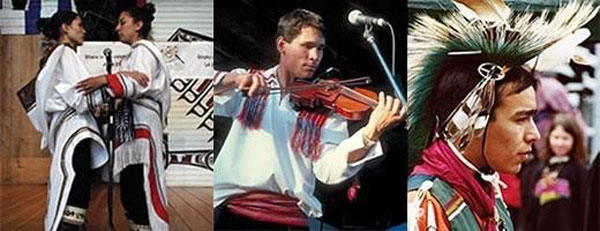
Indigenous Populations in Canada
- The overall Indigenous population (1,673,780) represent 4.9% of the Canadian population (34,460,065).
- Past censuses have emphasized two key characteristics of the Indigenous population: that Indigenous Peoples are both young in age and growing in number. Since 2006, the Indigenous population has grown by 42.7%— more than four times the growth rate of the non-Indigenous population.
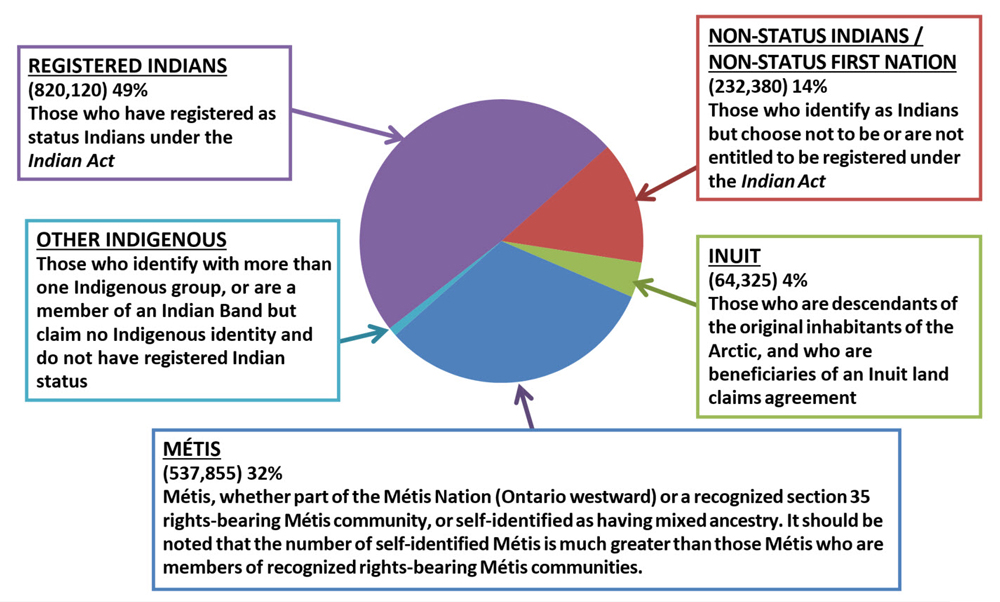
Text alternative for Indigenous Populations in Canada
- Registered Indians (820,120) 49%
Those who have registered as status Indians under the Indian Act - Non-status Indians / Non-status First Nation (232,380) 14%
Those who identify as Indians but choose not to be or are not entitled to be registered under the Indian Act - Inuit (64,325) 4%
Those who are descendants of the original inhabitants of the Arctic, and who are beneficiaries of an Inuit land claims agreement - Métis (537,855) 32%
Métis, whether part of the Métis Nation (Ontario westward) or a recognized section 35 rights-bearing Métis community, or self-identified as having mixed ancestry. It should be noted that the number of self-identified Métis is much greater than those Métis who are members of recognized rights-bearing Métis communities. - Other Indigenous
Those who identify with more than one Indigenous group, or are a member of an Indian Band but claim no Indigenous identity and do not have registered Indian status
History of Indigenous Policy in Canada
Early Contacts
- First Nations people and Inuit lived in what is present day Canada at time of contact
- Encountered settlers from 1534 to the early 1900s
- Engaged in trade, military alliances and Peace and Friendship Treaties
- Unions between First Nations women and settlers created a distinct Métis culture
Colonial and Canadian Era
- Royal Proclamation, 1763: British Crown acknowledged Indigenous rights to lands, established protocols for treaty-making and formalized the Crown-Indigenous relationship. A series of land surrender treaties were concluded in what is now Southern Ontario.
- After being considered military allies, Indigenous peoples were increasingly viewed as a detriment to the proper development of the colonies
- Policies of Civilization 1820s: new policies are put in place to create reserve lands for First Nations while encouraging Indigenous communities to abandon traditional ways of life for ones more similar to that of British settlers.
- Education and lands 1840s and 1850s: increased efforts are placed on establishing schools for Indigenous children and the imposition of settler concepts of land ownership
- British North America Act, 1867: section 91(24) assigns federal jurisdiction over "Indians, and lands reserved for the Indians".
- Numbered Treaties, 1871-1921: 11 numbered treaties signed in Ontario, Manitoba, British Columbia, Alberta, Yukon and Northwest Territories for respectful co-existence, some treaties included socio-economic provisions, such as a medicine chest, schools or economic means (e.g. "cows and plows").
- Indian Act, established in 1876, as a means of assimilation, which led to direct control of communities and reserves, imposition of education systems, controlled movement of Indians through pass system, gender discrimination against women who married non-Indigenous men and loss of status via enfranchisement.
- Paternalism 1880s-1950s: despite the creation of wide-ranging social, health care and education programs, the core activities of the Department focus on efforts to control Indigenous Peoples such as through residential schools and forced relocations
- Bryce Report, 1907: Chief Medical Health Officer, Dr. Peter Henderson Bryce, submitted a report to the Department, revealing that overcrowding and unsanitary living conditions in residential schools were spreading disease and that students were dying from it. Deputy superintendent Duncan Campbell Scott disregarded the report and prevented it from being officially published.
- Federal proposals to transfer on-reserve service delivery to provinces resulted in only the Canada-Ontario 1965 Indian Welfare Agreement.
Activism and Rights Assertions
- 1940s: in the post-war period, regional Indigenous organizations are formed to advocate for changes to policies and improvements to the deteriorating state of Indigenous communities.
- 1969: White Paper – federal policy statement intended to repeal the Indian Act and assimilate Indigenous Peoples into broader Canadian society; Indigenous Peoples responded with Red Paper for recognition of Indigenous Peoples and their treaty rights.
- 1971: National Indian Brotherhood, later Assembly of First Nations (AFN), provides Canada-wide representation of Indigenous Peoples. Also, 1971 marks the creation of Inuit Tapiriit Kanatami (ITK), the primary organization representing Inuit in Canada, out of concerns of Inuit leaders regarding land and resource ownership in Inuit Nunangat.
- 1983: Creation of the Métis National Council (MNC), the organization representing the Métis Nation nationally and internationally.
Recognition
- Modern Treaties 1873: the Calder decision of 1973 pushes the Government of Canada to recognize outstanding Indigenous rights over lands and the adoption of the comprehensive land claims process to negotiate new treaties with Indigenous communities.
- Section 35 of Constitution Act, 1982, recognizes and affirms Aboriginal and treaty rights of Indigenous Peoples (defined as First Nations, or "Indians," Inuit and Métis).
- Indigenous Peoples advocated for their recognition during attempted Meech Lake Accord, 1990 and Charlottetown Accord, 1992.
- 1991-1996: Royal Commission on Aboriginal Peoples made 350 recommendations, including the enactment of legislation and creation of institutions that would provide the authority for Indigenous Peoples' self -determination.
Devolution and Community-based Services
- Over the years, colonial policies have existed that contributed to the disempowerment of Indigenous Peoples. However, progress has been made to recognize and implement Indigenous rights and self -determination.
- Indigenous Control 1970s-1980s: federal programs and policies are changed to allow for increased local control by community governments, starting with schools and education services in the 1970s and later for band governance in the 1980s.
- Indian Health Policy, 1979: development of a new policy approach to First Nation health-care that focuses on a more inclusive and community led services.
- Cree Naskapi Act, 1984 and Sechelt Indian Band Self-Government Act, 1986: first agreements to pull First Nations outside of Indian Act to create self-government.
- Inherent Right Policy, 1995: establishment of a negotiated process to establish self -government agreements resulted in 22 agreements across 43 communities, and is a central component to Modern Treaties.
- First Nations Land Management Act, 1999: creation of a regime for First Nations to opt-out of 40 Indian Act provisions on land, environment and resources, to develop their own land and resources management codes. Similar regimes established in a range of areas, including fiscal management, First Nations elections, commercial development, and oil and gas management.
- Self-determination through federalism:
- 1999: Territory of Nunavut created; and
- 2014: Northwest Territories became the second territory to take over land and resources responsibilities, as the final major step in the territory's devolution process.
Modernizing Services
- 2015: the Truth and Reconciliation Commission examining the impacts of Residential Schools issues 94 Calls to Action to guide the reconciliation between Indigenous and non-Indigenous Peoples in Canada.
- 2017: announcement of the dissolution of Indigenous and Northern Affairs Canada (INAC) and creation of two new departments: Indigenous Services Canada (ISC) and Crown-Indigenous Relations and Northern Affairs Canada (CIRNAC).
- 2017: First Nations and Inuit Health Branch (FNIHB) joins ISC after 70 years of operation under Health Canada.
- ISC is committed to supporting and empowering Indigenous control over delivery of services and improving socio - economic conditions and quality of life in First Nations, Inuit and Métis communities; key to Indigenous self - determination.
- 2019:
- A legislative mandate for ISC to work towards the transfer of departmental responsibilities and collaborate with Indigenous partners in all aspects of service delivery.
- The Act respecting First Nations, Inuit and Métis children, youth and families became an official law, and on January 1, 2020, its provisions came into force.
- The Indigenous Languages Act which is intended to support the reclamation, revitalization, maintaining and strengthening of Indigenous languages received Royal Assent.
- 2020-21: COVID response sees unprecedented investments in programs and services to support Indigenous communities and businesses through the pandemic and strengthened partnership with Indigenous leadership.
- 2021:
- Federal Pathway to Address Missing and Murdered Indigenous Women, Girls and 2SLGBTQQIA+ People is launched.
- United Nations Declaration on the Rights of Indigenous Peoples Act received Royal Assent.
Demographic Trends
- In 2016, 1,673,785 people self-identified as an Indigenous Person in Canada, accounting for 4.9% of the total population
- This is a 42.7% increase from 2006 – a rate more than 4 times greater than non-Indigenous population – making Indigenous Peoples the fastest growing population in Canada
- Between 2006 and 2016:
- Registered Indian population grew by 31.5% to 820,120 people
- Non-Status First Nation population grew by 74.5% to 232,380 people
- Métis population grew by 51.3% to 537,855 people*
- Inuit population grew by 31.0% to 64,330 people
- As of 2016, 4 in 10 registered Indians live on-reserve (331,030)
- Increase from 2011 when 315,995 registered Indians lived on-reserve
- 44,620 residents of reserves were not Registered Indians
- This population is also the focus the majority of ISC spending
- 57.9% of Indigenous Peoples reported living in off-reserve population centres in 2016
- Indigenous Peoples are the youngest population in Canada
- About 44% were under age 25 in 2016, compared to 28% for non-Indigenous people
- By 2036, the Indigenous population is projected to number between 2.0 and 2.6 million, which will represent between 4.6% and 6.1% of the Canadian population.
*The growth in the Métis and Non-Status First Nation populations are not solely due to natural growth but rather an increase in the number of individuals self-identifying as Métis or Non-Status First Nation.
Current Gaps and Challenges
HEALTH AND SOCIAL
- First Nations and Inuit populations are affected by major health issues, including lower life expectancy, higher rates of chronic illnesses (e.g., diabetes) and communicable diseases (e.g., tuberculosis, HIV/AIDS), higher infant mortality rates and higher suicide rates, relative to the broader Canadian population.
- The three-year rate of tuberculosis from 2016 to 2018 was 0.5 cases per 100,000 population for the non-Indigenous Canadian-born population. This compares to:
- First Nations with status living on-reserve: 24.3 cases per 100,000
- Inuit in Inuit Nunangat: 211 cases per 100,000
- The infant mortality rate for the non-Indigenous population in Canada was 4.4 per 1,000 singleton births. This compares to:
- First Nations: 9.2 per 1,000 singleton births (2.1 times higher)
- Inuit: 12.3 per 1,000 singleton births (2.8 times higher)
- Métis: 10.5 per 1,000 singleton births (2.4 times higher)
- The projected life expectancy at birth for the non-Indigenous population in Canada was 81.4 years for males and 87.3 for females. This compares to:
- First Nations: 72.5 for males and 77.7 for females
- Inuit: 70.0 for males and 76.1 for females
- Métis: 76.9 for males and 82.3 for females
- Gaps in basic living conditions (e.g., housing, water) also have significant impacts on long-term health status improvements.
- First Nations and Inuit people also face many of the same emerging health priorities as other Canadians (e.g., aging, mental health), but often with more acute consequences due to their poorer access to immediate and preventative health services.
- Indigenous children currently represent 52.2% of children in foster care while accounting for only 7.7% of the overall population of children under 15.
HOUSING
6.0% of the non-Indigenous population lived in a dwelling in need of major repairs in 2016. This compares to:
- Registered Indian on-reserve: 40.0%
- Registered Indian off-reserve: 12.2%
- Non-Status Indian: 12.3%
- Inuit: 21.8%
- Métis: 10.3%
The proportion of non-Indigenous dwellings classified as crowded was 1.8% in 2016. This compares to:
- Registered Indian on-reserve: 12.7%
- Registered Indian off-reserve: 2.7%
- Non-Status Indian: 1.1%
- Inuit: 16.0%
- Métis: 0.8%
Homelessness
- 30% of homeless 19,536 respondents across 61 communities in Canada identified as an Indigenous Person, with the majority identifying as First Nations
EDUCATION
There remain persistent gaps in educational attainment among 25 to 64 year olds. The non-Indigenous population with high school education or higher was 89.2% in 2016. This compares to:
- Registered Indian on-reserve: 57.0%
- Registered Indian off-reserve: 75%
- Non-Status Indian: 80.3%
- Inuit: 55.9%
- Métis: 82.3%
The proportion of non-Indigenous Peoples with university (Bachelor or higher) education increased from 20.1% in 2001 to 29.3% in 2016. This compares to:
- Registered Indian on-reserve: 3.4% in 2001 and 5.4% in 2016.
- Registered Indian-off reserve: 6.8% in 2001 and 11.3% in 2016.
- Non-Status Indian: 7.0% in 2001 and 11.9% in 2016.
- Inuit: Inuit with university-level education was 2.5% in 2001 and 5.3% in 2016.
- Métis: Métis with university-level education was 7.0% in 2001 and 13.6% in 2016.
- Although persistent, the gap in educational attainment between the Indigenous and non-Indigenous populations is shrinking particularly amongst the Inuit and Métis where the proportion of those with a university education nearly doubled from 2001 to 2016.
- In 2019, ISC introduced a new funding formula that ensures that base funding provided for Education is comparable to provincial systems across the country.
EMPLOYMENT
Employment rates were 62% in 2001 and 60.5% in 2016 for Canada's non-Indigenous population. This compares to:
- First Nations: Employment rate for Registered Indians on reserve decreased slightly from 37% in 2001 to 36.3% in 2016.
- Registered Indians off-reserve: the employment rate increased from 48% in 2001 to 50.7% in 2016.
- Non-Status Indians: the employment rate increased slightly from 56% in 2001 to 56.5% in 2016.
- Inuit: Employment rate for Inuit remained stable between 49% in 2001 to 48.9% in 2016
- Métis: Employment rate for Métis increased slightly from 60% in 2001 to 60.5% in 2016.
INCOME
Substantial gaps in median employment income persist between Indigenous and non-Indigenous Peoples. The median income of the non-Indigenous population in 2015 was $34,013. This compares to:
- Registered Indian on-reserve: $17,251
- Registered Indian off-reserve: $26,304
- Non-Status Indian: $26,525
- Inuit: $20,939
- Métis: $31,675
INTERGENERATIONAL IMPACTS
- Residential Schools: An estimated 150,000 Indigenous children were removed and separated from their families and communities to attend residential schools between 1831 and 1996.
- Relocation and Displacement: The forced relocation of Inuit families to the High Arctic in the 1950s to exert Canadian sovereignty in the North resulted in dislocation and starvation. Inuit families were broken up as loved ones were sent to southern Canada for medical treatment during the tuberculosis epidemic, which lasted from the 1940s to the 1960s, many never to return.
- Sixties Scoop: Over 11,000 First Nations children* were taken from their home and families and placed in foster care, and eventually adopted out to non-Indigenous families across Canada and the United States.
- Unmarked burials: Several unmarked burial sites have been located near former residential schools across Canada in the last year acting as a stark reminder of past injustices and a call to action to fulfill the Truth and Reconciliation Calls to Actions, particularly 71-76.
Key Reconciliation Milestones
Royal Commission on Aboriginal Peoples, 1991-1996
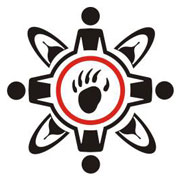
- 350 recommendations
- Recognition and implementation of the right to self-determination, as well as enactment of legislation to create new laws and institutions to provide authority and tools for Indigenous peoples to structure their own political, social and economic future
- Gathering Strength, Canada's response to the report is released in 1997
The Truth and Reconciliation Commission

- Initiated by 2006 Indian Residential Schools Settlement Agreement and 2008 statement of apology, combined with findings of the Royal Commission on Aboriginal Peoples led to the launch of a national Truth and Reconciliation Commission
- Final report was released in 2015 with 94 Calls to Action to:
- renew the relationship and decolonize institutions
- close socio-economic gaps and foster healing
- engage and educate Canadians
- Canada's response being advanced through various initiatives (e.g., Indigenous Languages Act, United Nations Declaration on the Rights of Indigenous Peoples Act Legislation, amending the Oath to Citizenship, establishing National Day for Truth and Reconciliation as an official federal statutory holiday to be marked annually on September 30, 2021, etc.)
National Inquiry into Missing and Murdered Indigenous Women and Girls
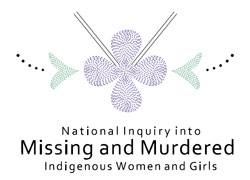
- High rates of missing and murdered Indigenous women and girls caused the Government of Canada to launch a national inquiry in 2016, independent from the federal government
- Final report was released in 2019 with 231 Calls to Justice
- Federal Pathway to Address Missing and Murdered Indigenous Women, Girls and Two-Spirit, lesbian, gay, bisexual, transgender, queer, questioning, intersex and asexual People is launched in June 2021
Examples of Progress Towards Self-Determination
Education Transformation Regional Education Agreements
• Establishment of unique education agreements that were/are supported by a combination of the participating First Nations' core K-12 education funding and proposal-based funding:
- The Tripartite Education Framework Agreement in British Columbia (2012-2017)
- The Manitoba First Nations School System in Manitoba (2017)
- The Maskwacis Education Services Commission in Alberta (2018)
- Kee Tas Kee Now Tribal Education Authority in Alberta (2019)
- Athabasca Denesuline Education Authority in Saskatchewan (2019)
- Peter Ballantyne Cree Nation Education Authority in Saskatchewan (2020)
- Whitecap Dakota Tripartite Regional Education Agreement in Saskatchewan (2020)
- Elsipogtog First Nation Education Authority in New Brunswick (2021)
- Treaty Education Alliance in Saskatchewan (2021)
Child and Family Services
- An Act Respecting First Nations, Inuit and Métis Children, Youth and Families, 2019
- First co-developed legislation between the Government of Canada and First Nations, Inuit and Métis representatives to reform Indigenous Child and Family Services
- Affirms the rights of First Nations, Inuit and Métis to exercise jurisdiction over Child and Family Services to keep families together and reduce the number of Indigenous children in foster care
- As of August 2021, over 100 Indigenous groups and communities had started to develop Indigenous Child and Family Services policies, models and laws based on their particular histories, cultures, and circumstances. Some 73 proposals and more than $30 million in funding to build capacity has been approved for communities in preparation for exercising jurisdiction over Child and Family Services.
- Progress has been made towards having Indigenous Child and Family Services laws receive force of law as federal law through tripartite coordination agreements under the Act, with 17 coordination agreement discussions ongoing, one completed with Cowessess First Nation, and about 20 discussions expected to begin annually over the next few years.
COVID-19 Response
- Over the course of 2020 and 2021, Canada worked closely with Indigenous partners to support community-led responses to COVID-19 through existing ISC programming, significant new investments in public health, and a variety of financial supports to mitigate the economic impacts of the pandemic.
United Nations Declaration on the Rights of Indigenous Peoples Act
- The United Nations Declaration on the Rights of Indigenous Peoples Act received Royal Assent in June 21, 2021, and immediately came into force.
- The legislation advances the implementation of the Declaration as a key step in renewing the Government of Canada's relationship with Indigenous Peoples and provides a framework for reconciliation, healing and peace, as well as harmonious and cooperative relations based on the principles of justice, democracy, respect for human rights, non-discrimination and good faith.
Fiscal Management
- First Nations Fiscal Management Act, 2006, provides First Nations with support and tools to strengthen local economies.
- Established key institutions – the First Nations Financial Management Board (FNFMB), the First Nations Finance Authority (FNFA) and the First Nations Tax Commission (FNTC).
Modern Treaties and Land Claims
- Treaties define rights, benefits and obligations for the signatories. Modern treaties can cover land ownership, financial settlements, self-government, and resource revenue sharing.
- The James Bay and Northern Quebec Cree Agreement was the first modern treaty. Canada has since signed 25 additional treaties with Indigenous groups, including modern land claims with the four Inuit regions.
- Modern treaties form the basis of Canada's relationship with 97 Indigenous communities (representing about 89,000 Indigenous Peoples). These agreements provide holders certainty on land rights for around 40% of Canada's land mass.
First Nations Land Management
- Since 1999, First Nations can opt-out of 44 sections of the Indian Act on land management and develop their own laws about land use, environment and natural resources, pursuant to the First Nations Land Management Act (FNLMA).
- There are currently 99 First Nations that are managing their lands pursuant to the First Nations Land Management Act, with an additional 62 in the process of developing their land codes.
- Similar opt-in legislations to the First Nations Land Management Act have been created to increase First Nations control over elections, oil and gas management as well as commercial development.
Self-Government Agreements with Métis Nation in Ontario, Alberta and Saskatchewan
- First self-government agreements signed with the Métis governments in 2019.
- Agreements recognize Métis jurisdiction in core governance areas, including citizenship, leadership and land development.
Some Current Indigenous Priorities
First Nations
- Climate change
- Recovery post-pandemic
- Nation re-building and rights recognition
- New fiscal relationship
- Child & Family Services and Jordan's Principle*
- Sixties Scoop claims process
- Implementation of United Nations Declaration on the Rights of Indigenous Peoples Act
- Truth and Reconciliation Commission of Canada's 94 Calls to Action plus Missing and Murdered Indigenous Women and Girls National Inquiry's 231 Calls to Justice
- Trauma-informed mental health and cultural supports
- Policing and community safety
- Infrastructure (access to clean water, emergency management, etc.)
Inuit
- Inuit-Crown land claims
- Inuit Nunangat policy space
- Recovery post-pandemic
- Inuktut revitalization, maintenance, and promotion
- Reconciliation measures
- Education, early learning, and training
- Health and wellness (COVID-19 relief, tuberculosis elimination, Inuit-led suicide prevention, etc.)
- Environment and climate change
- Housing and infrastructure
- Economic development and procurement
- Legislative priorities
- Food security
- Implementation of the United Nations Declaration on the Rights of Indigenous Peoples Act
Métis Nation
- Governance
- Recognition
- Reconciliation
- Recovery post-pandemic
- Improving socio-economic conditions
- Implementation of the United Nations Declaration on the Rights of Indigenous Peoples Act
- Implementation of the Supreme Court's Daniels decision
*Jordan's Principle is a child-first principle that is a legal obligation of Canada to address the unmet needs of First Nations children in health, social and education, no matter where they live in Canada.
*Information based on Assembly of First Nations, Inuit Tapiriit Kanatami, Native Women's Association of Canada and Congress of Aboriginal Peoples election priorities, and existing Métis National Council statements.
Recent Trends
Self-determination and service transfer*
- There has been an acceleration of the movement to increase Indigenous control over services delivered to Indigenous citizens. The COVID-19 response has provided some important lessons that will inform the transfer of services (e.g., capacity of Indigenous leadership to response to crisis situations and meet the needs of their members). In addition, Tripartite Emergency Management Agreements are an instrumental mechanism used for priority setting and planning in response to other emergencies, such as severe wildfires.
- Legislation asserting First Nations' jurisdiction over Child and Family Services, to ensure that First Nations can control how these critical services are delivered. Policy work to transfer program responsibilities through initiatives such as the Atlantic First Nations Water Authority.
- Over 115 First Nations now benefitting from 10-year grants, providing fiscal flexibility for First Nations leadership to operate outside the restrictive parameters of contribution agreements to manage their funds.
*Work ongoing to clarify the differences and interplay between service transfer agreements under section 9 of the Department of Indigenous Services Act and agreements under section 35 of the Constitution.
Litigation Management
- Supreme Court decisions such as Daniels (2016) expanded the meaning of Indians in the constitution to include Métis and non-status people.
- Since 2016, Canadian Human Rights Tribunal orders have instructed Canada to stop discriminatory practices in the delivery of health and social services to First Nations children (Jordan's Principle and Child and Family Services) and have issued a series of remedial orders that have expanded the definition of a First Nations child for the purposes of eligibility under Jordan's Principle.
- Class action litigation is on the rise in the context of services delivered by the federal government to Indigenous Peoples. Canada recently reached an Agreement-in-Principles to resolve a class action litigation related to safe drinking water in First Nation communities.
Reconciliation
- Addressing the legacy of residential schools, particularly around the issue of the continued identification of unmarked burials.
- Addressing systemic racism particularly in health and justice.
2. Overview of Indigenous Services Canada
Role of the Minister of Indigenous Services
"The Minister is to ensure that: child and family services; education; health; social development; economic development; housing; infrastructure; emergency management; and governance services are provided to eligible Indigenous individuals, communities and governing bodies." (Department of Indigenous Services Act, s.6 (2))
The Minister is to "provide Indigenous organizations with an opportunity to collaborate in the development, provision, assessment and improvement of the services" and is to "take the appropriate measure to give effect to the gradual transfer to Indigenous organizations of departmental responsibilities". (Department of Indigenous Services Act, s.7(a-b))
The Minister must cause to be tabled in each House of Parliament, within three months after the end of the fiscal year (…) a report on:
- the socio-economic gaps between First Nations, Inuit, Métis individuals, and other Canadians and the measures taken by the Department to reduce those gaps; and
- the progress made towards the transfer of responsibilities."
(Department of Indigenous Services Act, s.15)
Overview of Services
Indigenous Services Canada (ISC) provides programs and services to First Nations, Inuit and Métis peoples, which focus on:
- keeping children and families together,
- supporting quality education,
- improving health outcomes,
- building reliable infrastructure, and
- enabling economic prosperity.
First Nations, Inuit and Métis covered by self-government agreements receive services directly from their Indigenous government. These relationships fall mainly under the mandate of Crown-Indigenous Relations and Northern Affairs Canada.
First Nations, Inuit and Métis
- ISC also supports a wide range of Indigenous governments and institutions who serve and represent First Nations, Inuit and Métis.
- First Nations, Inuit and Métis students can also receive support for post-secondary education support.
- Urban Programming for Indigenous Peoples is delivered through not-for-profit urban Indigenous service delivery organizations (i.e., Friendship Centres, Inuit and Métis organizations) and non-Indigenous organizations, including municipal governments, health and education authorities and institutions that have demonstrated support from Indigenous organizations or Indigenous community groups.
Common to First Nations and Inuit
- First Nations and Inuit communities have access to a range of services that are supplementary to those provided by the provinces and territories, including mental health and substance use services, public health services, home, community, and palliative care.
- Some services are available to First Nation individuals and Inuit regardless of residency (e.g., non-insured health benefits, access to health, social, and educational services for children through Jordan's Principle and the Inuit Child First Initiative, and post-secondary education funding).
- Inuit have self-government agreements and governance structures that allow for greater community control.
- ISC funds communities, service delivery organizations and, in some instances, delivers the services directly (e.g., nursing).
On-reserve First Nations
- ISC is involved in a wide range of services for on-reserve First Nations, similar to a province/territory or municipalities. This includes health, social, education, economic development, governance, and infrastructure services.
- In these cases, ISC's main role is one of funder, via contribution agreements, to First Nation governments and organizations who manage service delivery.
- The New Fiscal Relationship provides stabilized long-term funding to over 117 First Nations through the 10-year grant funding mechanism. This initiative aims to provide eligible First Nations, who choose to join the grant, with program supports to build capacity, do effective planning, and account for inflation and population increases on-reserve.
- The main services supported by the Department on-reserve include status registration, estates, primary care nursing, public health nurses and environmental public health, elementary and secondary education, post-secondary education, income assistance, assisted living, infrastructure such as housing, water and waste water, and education and health facilities among others.
Responding to COVID-19
- Recognizing that many Indigenous communities face unique challenges in addressing COVID-19, ISC has provided funding to help First Nations, Inuit and Métis communities, as well as urban Indigenous service delivery organizations to manage the pandemic, and to recover from the impacts of the pandemic.
- To support First Nations communities' efforts to mitigate and manage COVID-19 outbreaks on-reserve, ISC provided additional supports, including:
- COVID-19 swab sample testing;
- personal protective equipment, such as hand sanitizer, N95 masks, isolation shields, and gloves;
- deployed nurses, paramedics and provided air transportation for health human resources;
- provided funding for mobile structures, hotel or space rentals;
- provided logistics support identifying community spaces that can be upgraded or retooled; operational spaces for site servicing projects; and
- rolling out vaccination.
A National Footprint
National Capital Region
- The National Capital Region (NCR) office of Indigenous Services Canada plays an important role in defining the general policy direction of the department.
- It also maintains relationships with Indigenous organizations located in the National Capital Region, including the Assembly of First Nations, Inuit Tapiriit Kanatami, the Métis National Council, the Congress of Aboriginal Peoples, and the Native Women's Association of Canada.
Regional Offices
- The regional offices of ISC are the face of the Department in direct work with Indigenous communities.
- Located in all continental provinces, the Atlantic region, and in some northern regions (Northwest Territories and Yukon), they maintain day-to-day relationships with a wide web of Indigenous organizations and governments at the local and regional levels.
- ISC offices are also responsible to ensure that programs are appropriately implemented.
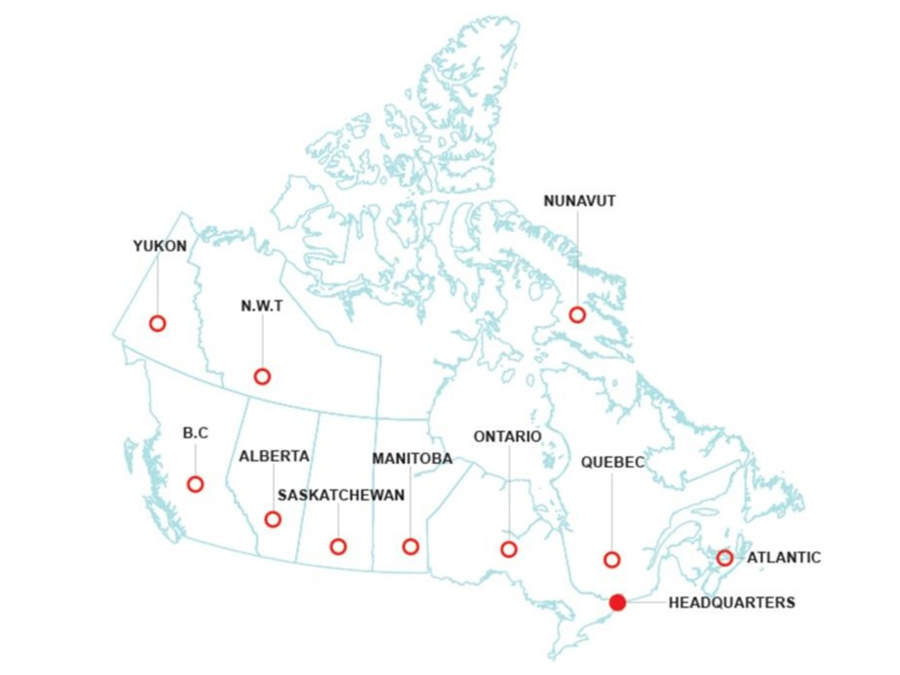
Legislative Environment
Constitution Act, 1982
- Section 91(24) provides the Government of Canada with jurisdiction over "Indians and lands reserved for Indians".
- Section 35 recognizes and affirms "Aboriginal and treaty rights".
Department of Indigenous Services Act
- Came into force in July 2019.
- Outlines the powers, duties and functions of the Minister of Indigenous Services. It directs the Minister to ensure programs and services are delivered to eligible Indigenous individuals and emphasizes the objectives of closing socio-economic gaps between Indigenous Peoples and other Canadians, and of building capacity of Indigenous communities to support self-determination.
- The legislation notably includes:
- the different types of services provided to eligible Indigenous individuals (i.e., child and family services; education; health; social development; economic development; housing; infrastructure; emergency management; and governance);
- responsibilities to ensure that Indigenous organizations can collaborate in the development, provision, assessment and improvement of services.
- a ministerial power to enter into agreements with Indigenous organizations to transfer departmental responsibilities.
Indian Act
- Regulates the relationship between Canada and First Nations in a wide range of areas.
- For the purposes of this Act, the Minister of Indigenous Services is the Superintendent General of Indian affairs.
Legislation for which the Minister of Indigenous Services is responsible:
- An Act respecting First Nations, Inuit and Métis children, youth and families
- Indian Act Amendment and Replacement Act
- First Nations Elections Act
- Indian Oil and Gas Act
- First Nations Oil and Gas and Moneys Management Act
- First Nations Commercial and Industrial Development Act
- Family Homes on Reserves and Matrimonial Interests or Rights Act
- Safe Drinking Water for First Nations Act
- Saskatchewan Treaty Land Entitlement Act
- Kanesatake Interim Land Base Governance Act
Influencing legislation:
- United Nations Declaration on the Rights of Indigenous Peoples Act
- Indigenous Languages Act
- First Nations Financial Transparency Act
- Addition of Lands to Reserves and Reserve Creation Act
- First Nations Fiscal Management Act
- First Nations Land Management Act
- Dominion Water Power Act
ISC Portfolio Organizations
Indian Oil and Gas Canada
- Indian Oil and Gas Canada (IOGC) is an organization committed to managing and regulating oil and gas resources on First Nation reserve lands. It is a special operating agency under ISC.
- Indian Oil and Gas Canada Vision: To become a modern regulator of First Nations oil and gas resources.
- Indian Oil and Gas Canada's general responsibilities are to:
- identify and evaluate oil and gas resource potential on Indian reserve lands;
- encourage companies to explore for, drill and produce these resources through leasing activity;
- ensure equitable production, fair prices and proper collection of royalties on behalf of First Nations; and
- secure compliance with and administer the regulatory framework in a fair manner.
ISC Ministerial Advisory Board
National Indigenous Economic Development Board
- The National Indigenous Economic Development Board's (NIEDB) mission is to advise the Minister of Indigenous Services and other federal Ministers on policies, programs, and program coordination as they relate to Indigenous economic development.
- National Indigenous Economic Development Board Vision: A vibrant Indigenous economy, where Indigenous Peoples are economically self-sufficient and have achieved economic parity with Canadian society.
- The Board is comprised of First Nations, Inuit, and Métis business and community leaders from across Canada. It helps governments respond to the unique needs and circumstances of Indigenous Peoples in Canada.
Annex A: History of Indigenous Service Delivery
First Nations and Inuit Health Branch
- 1904 – Medical programs and health facilities for Indians were developed in response to smallpox outbreak.
- 1974 – Minister of National Health and Welfare tabled "Policy of the Federal Government Concerning Indian Health Services."
- Mid-1980's – Work was undertaken to transfer the control of health services to First Nations and Inuit communities and organizations through the Strategic Policy, Planning and Analysis Directorate at Health Canada (renamed First Nations and Inuit Health Branch in 2000).
- In response to the Royal Commission on Aboriginal Peoples, the federal government announced Gathering Strength—Canada's Aboriginal Action Plan, which committed to addressing chronic illnesses of Indigenous Peoples, the development of Aboriginal Healing Foundation, and a healing strategy that addresses the legacy of Indian Residential Schools in partnership with the Department of Indian Affairs and Northern Development.
- Work continues toward the transfer of health services to communities (i.e. British Columbia First Nations Health Authority).
- Efforts remain ongoing to implement orders issued from the Canadian Human Rights Tribunal regarding the implementation of Jordan's Principle.
Schooling and Education
- 1830s – saw the introduction of Indian Residential Schools.
- 1940 – policy of education integration was introduced, enabling Indigenous students to attend provincial school. Issues with this approach included a lack of specialized training to teach Indigenous students and the fact that schools were often located far from students' homes.
- 1972 – the National Indian Brotherhood (later became the Assembly of First Nations) policy on Indian Control of Indian Education was adopted by the Department of Indian Affairs and Northern Development.
- 1970's – began to address the importance of local community control to improve education, identified the need for more Indigenous teachers and the development of relevant curricula.
- Recent efforts have contributed to federal and provincial legislation that formalizes the local jurisdiction for First Nations communities (i.e. Nisga'a Education Act, Mi'kmaq Education Act).
- Work remains ongoing, in collaboration with Indigenous partners, towards distinctions-based post-secondary education strategies.
Economic Development
- 2000s – saw an increased focus on economic development through legislative approaches to financial management and accountability.
- 2006 – First Nations Fiscal Management Act (FNFMA) was implemented. Includes:
- First Nations Financial Management Board (FNFMB);
- First Nations Tax Commission (FNTC); and,
- First Nations Finance Authority (FNFA).
- 2010 – the Strategic Partnership Initiative was created to provide a coordinated federal response to existing and emerging Indigenous economic development opportunities (e.g., in major projects).
- With the aim of addressing issues of underfunding and onerous reporting requirements for Indigenous communities, Canada entered into the Mi'kmaq-Nova Scotia-Canada Tripartite Forum.
- 2019 – the 10-year grant program was established to advance the New Fiscal Relationship with First Nations.
Community Infrastructure
- Canada provides funding and technical support for community infrastructure. First Nations communities are responsible for the procurement, construction, and operations and maintenance of their community infrastructure.
- Underfunding for community infrastructure on-reserve has resulted in poor living conditions (e.g., overcrowding in homes, mold infestations).
- The Government of Canada has made significant progress in recent years towards improving access to clean drinking water and ending long-term drinking water advisories in First Nations communities. An action plan is in place and initiatives are underway to address all remaining long-term advisories.
- As per the Department of Indigenous Services Act (2019), ISC is working with Indigenous partners on the development, provision, assessment and improvement of infrastructure services, with the ultimate goal, of the transfer of control of infrastructure services to Indigenous organizations.
Child and Family Services
- 1950s – an amendment to the Indian Act allowed governments to provide child welfare services on-reserve which resulted in the Sixties ScoopFootnote 1.
- 2007 – the Enhanced Prevention Focused Approach to Child and Family Services (EPFA) was introduced.
- 2016 – the Canadian Human Rights Tribunal ruled funding provided for on-reserve child and family services programming was discriminatory.
- June 2019 – Bill C-92, affirming and recognizing Indigenous Peoples' jurisdiction over child and family services was enshrined into law. The Government of Canada signed a coordination agreement with the Cowessess First Nations in Saskatchewan on July 6, 2021.
- Efforts remain ongoing to work with Indigenous partners to reform the First Nations Child and Family Services (FNCFS) program, which funds prevention and protection services for First Nations children and families living on-reserve.
Governance
- 1980s – Indian Government support programs were created to aid organizations in under taking administrative control over departmental programs. They are now known as the Indigenous Governance and Capacity programs and are currently available for communities.
- New guiding principles, created through the Indigenous Community Development National Strategy (2018), emphasize the need for community governance to: be community-driven, be nation-based, include the recognition of diversity, invest in capacity building, planning and implementation, and be flexible and responsive.
- Governance tools have been developed for communities and institutions to support their process in self-determination.
- ISC is co-developing a policy framework that paves the way for transferring infrastructure service delivery to First Nation partners. The framework encompasses the process and requirements for service transfer to ensure ISC staff and First Nations communities understand the implications of the transfer of control and accountabilities for infrastructure service delivery.
3. Indigenous Services Canada and Crown-Indigenous Relations and Northern Affairs Canada: Division of Responsibilities
Indigenous Services Canada's (ISC) primary responsibilities are the delivery of services and programs to Section 91(24) Indigenous communities, with a particular emphasis on closing the socio-economic gap between Indigenous Peoples and non-Indigenous Peoples and building up the capacity of Indigenous communities so that they have the means and ability to move forward on the path to self-determination.
Crown-Indigenous Relations and Northern Affairs Canada's (CIRNAC) primary responsibilities are to guide and coordinate the whole-of-government relationship with Section 35 rights holders and Indigenous nations; to reach and implement agreements to accelerate self-determination (through self-government and land claim agreements, including reconstituting nations); and to manage northern programing and Arctic Policy.
ISC Responsibilities (lead sector)
- Indigenous Health (First Nations and Inuit Health Branch)
- Housing and Infrastructure (Regional Operations Sector)
- Education (Education and Social Development Programs and Partnerships Sector)
- Social Services (Education and Social Development Programs and Partnerships Sector)
- Child and Family Services (Education and Social Development Programs and Partnerships Sector)
- Indian Status (Regional Operations Sector)
- Governance, Bylaws and First Nations Election Act (Lands and Economic Development Sector)
- Economic Development (Lands and Economic Development Sector)
- Economic Policy
- Aboriginal Entrepreneurship and Business Development
- National Indigenous Economic Development Board
- Matrimonial Real Property
- Lands under the Indian Act (Lands and Economic Development Sector)
- Environmental management (Lands and Economic Development Sector)
- Indian Oil and Gas Canada and First Nations Oil and Gas Management Act (Lands and Economic Development Sector)
- Evaluation (Strategic Policy and Partnerships Sector)
- Emergency Management (Regional Operations Sector)
- Fiscal Arrangements (Strategic Policy and Partnerships Sector)
Shared Internal Service housed in ISC
- Legislative, Parliamentary and Regulatory Affairs (Strategic Policy and Partnerships Sector)
- Communications (Deputy Minister's Office)
- Departmental Library (Chief Financial and Results Delivery Officer Sector)
CIRNAC Responsibilities (lead sector)
Crown-Indigenous Relations
- Permanent Bilateral Mechanisms (Policy and Strategic Direction Sector)
- Inuit and Métis Housing (Policy and Strategic Direction Sector)
- Recognition and Implementation of Rights Framework (Treaties and Aboriginal Government Sector)
- Land Claims Negotiations (Treaties and Aboriginal Government Sector)
- Modern Treaty and Self-Government negotiations (Treaties and Aboriginal Government Sector)
- Specific Claims (Treaties and Aboriginal Government Sector)
- Treaty implementation (Implementation Sector)
- Residential Schools Resolution (Resolution and Partnerships Sector)
- First Nations Financial Management Act (Resolution and Partnerships Sector)*
- First Nations Land Management Act (Resolution and Partnerships Sector)*
- Additions to Reserves (Resolution and Partnerships Sector)*
- Audit (Deputy Minister's Office)
* While CIRNAC retains legislative authority/approval over First Nations Land Management Act and Additions to Reserve legislation, operational elements associated with these regimes are be undertaken by ISC (via the regional offices).
Northern Affairs (Northern Affairs Organization)
- Territorial governments
- Devolution
- Arctic and Northern Policy Framework
- Arctic Science
- Nutrition North
- Polar Knowledge Canada
- Contaminated sites
Shared Internal Service housed in CIRNAC
- Human Resources
- Cabinet Affairs (Policy and Strategic Direction)
4. Profiles of Indigenous Services Canada Senior Executives
October 2021

Text alternative for Indigenous Services Canada Senior Executives org chart
- Minister of Indigenous Services
- Deputy Minister: Christiane Fox
- Associate Deputy Minister: Valerie Gideon
- Regional Operations: Senior ADM, Joanne Wilkinson
- Regional Offices South of 60°
- First Nations and Inuit Health Branch: Senior ADM, Patrick Boucher
- Regional Operations, First Nations and Inuit Health Branch: ADM, Keith Conn
- Regional Offices First Nations and Inuit Health Branch
- Chief Finances, Results and Delivery Officer: Philippe Thompson
- Child and Family Services Reform: ADM, Catherine Lappe
- Lands and Economic Development: ADM, Kelley Blanchette
- Indian Oil and Gas Canada: Executive Director and CEO, Strater Crowfoot
- Strategic Policy and Partnerships: ADM, Gail Mitchell
- Corporate Secretariat: Corporate Secretary, Kyle McKenzie
- Education and Social Development Programs and Partnerships: ADM, David Peckham
- Common services to ISC and CIRNAC
- Human Resources and Workplace Services: Director General, Maryse Lavigne
- Audit and Evaluation: Acting Chief Executive, Stephanie Barozzi
- Communications: Director General, Aruna Sadana
- Legal Services: Senior General Counsel, Marie Bourry
- Regional Operations: Senior ADM, Joanne Wilkinson
Deputy Minister

Name: Christiane Fox
Telephone number: (613) 614-1658
Christiane Fox was appointed to the position of Deputy Minister of Indigenous Services Canada in September 2020. She is also the Deputy Minister Champion of the Federal Youth Network.
Prior to her appointment, Christiane had been the Deputy Minister of Intergovernmental Affairs since November 2019, and the Deputy Minister of Intergovernmental Affairs and Youth from June 2017 to November 2019. She also held several positions at the Privy Council Office, including Assistant Secretary to the Cabinet, Communications and Consultations, Director of Operations, Policy, in the Federal-Provincial-Territorial Relations Secretariat, and Director General of Communications.
Christiane started her career as a Communications Advisor at Industry Canada, now Innovation, Science and Economic Development Canada, where she worked in Communications, and in Science Policy. She also spent a year with the Competition Policy Review Secretariat, as the Director of Communications and Consultations.
Christiane has a BA in Mass Communications and Psychology from Carleton University, and is a graduate of the University of Ottawa's Masters Certificate Program in Public Administration.
Associate Deputy Minister

Name: Valerie Gideon
Telephone number: (613) 219-4104
In September 2020, Valerie Gideon was appointed Associate Deputy Minister of Indigenous Services Canada.
Prior to her appointment, Valerie held the position of Senior Assistant Deputy Minister for the First Nations and Inuit Health Branch (FNIHB) since April 2018, having acted in that position since December 2017. Prior to that role, Valerie was Assistant Deputy Minister, Regional Operations, FNIHB. In 2011–2012, she was Director General, Strategic Policy, Planning and Analysis at FNIHB. From 2007 to 2010, she held the position of Regional Director for First Nations and Inuit Health Branch, Ontario Region, Health Canada. Prior to working at Health Canada, her experience consisted mainly of working in First Nations health advocacy as Senior Director of Health and Social Development at the Assembly of First Nations and Director of the First Nations Centre at the National Aboriginal Health Organization. She was named Chair of the Aboriginal Peoples' Health Research Peer Review Committee of the Canadian Institutes of Health Research in 2004.
Valerie graduated from McGill University (Montreal) in 2000 with a Ph.D. (Dean's List) in Communications (dissertation pertaining to telehealth and citizen empowerment). She previously completed a Masters of Arts in 1996 at McGill. She is a founding member of the Canadian Society of Telehealth and former Board member of the National Capital Region YMCA/YWCA. Valerie is a member of the Mi'kmaq Nation of Gesgapegiag, Quebec, Canada.
Regional Operations

Name: Joanne Wilkinson
Title: Senior Assistant Deputy Minister
Telephone number: (613) 415-5423

Name: Danielle White
Title: Assistant Deputy Minister and Special Advisor
Telephone number: (613) 884-3697
Overview
Regional Operations is responsible for the delivery of national programs and services through seven south of 60° regional offices. Programs include those offered by the Education and Social Development Programs and Partnership Sector as well as the Lands and Economic Development Sector.
Regional Operations is also responsible for managing three national programs, which include Governance Capacity, Community Infrastructure and Emergency Management.
Governance Capacity
Governance Capacity provides funding for band governance and administration: funding to eligible First Nations, Inuit or Innu employers to support pension and benefit plans; core funding to Tribal Councils; and targeted funds to governance capacity development projects. This funding is intended to support Indigenous communities and institutions in the implementation of strong and sustainable governments.
Community Infrastructure
Community Infrastructure works with First Nations governments to support affordable and adequate housing; the provision of clean, safe and reliable drinking water and the effective treatment of wastewater on First Nations lands; the provision of safe schools; and other community infrastructure essential to healthy, safe, and prosperous communities, such as roads and bridges.
Emergency Management
The Emergency Management Assistance Program supports the health and safety of on-reserve First Nations residents as well as their lands and critical infrastructure. This program promotes a four pillar approach to emergency management: mitigation; preparedness; response; and recovery. ISC promotes efficiency by accessing existing resources and services of provinces and territories and emergency management partners to address on-reserve emergencies and reimburses these partners for eligible expenses.
Regional Offices South of 60°
Atlantic Region

Name: Daniel Kumpf
Title: Regional Director General
Telephone number: (902) 397-0207
Alberta Region

Name: Jamie Brown
Title: Regional Director General
Telephone number: (780) 554-4699
British Columbia Region

Name: Allyson Rowe
Title: Regional Director General
Telephone number: (604) 355-3018
Saskatchewan Region

Name: Rob Harvey
Title: Regional Director General
Telephone number: (306) 536-9929
Manitoba Region

Name: Kandice Léonard
Title: Regional Director General
Telephone number: (204) 430-6768
Ontario Region

Name: Anne Scotton
Title: Regional Director General
Telephone number: (613) 794-0014
Quebec Region

Name: Luc Dumont
Title: Regional Director General
Telephone number: (418) 951-7304
Chief Finances, Results And Delivery Officer

Name: Philippe Thompson
Title: Chief Finances, Results and Delivery Officer
Telephone number: (613) 355-0247
Overview
The Chief Finances, Results and Delivery Officer Sector is responsible for providing leadership and ensuring effective management of departmental resources within the legislative mandate. The Sector also provides strategic advice, oversight, and support to the Deputy Minister and the senior executive team to ensure integrity and sound financial controls and management in the planning and operations of Indigenous Services Canada (ISC).
The Sector is responsible for establishing the planning framework for ISC that aligns the mandated outcomes and departmental strategic priorities with resource management via the Departmental Results Framework. The Chief Finances, Results and Delivery Officer leads the reporting to Cabinet and Parliament on outcomes through the Departmental Plan and Departmental Report and the implementation of the Minister's mandate letter commitments.
The Chief Finances, Results and Delivery Officer Sector supports delivery of services through policies, directives and other activities in the areas of financial planning and analysis, accounting and reporting, contracting and procurement, assets and materiel and information management.
The Chief Finances, Results and Delivery Officer is responsible for ISC's Chief Information Officer functions that include information management and technology services, investments structures and controls within ISC, to leverage Information Management and Information Technology reliably, securely, and cost effectively to support effective and efficient business process design and execution.
The Sector is accountable for providing grants and contributions advisory and support services through policies, directives and other activities, including the development of national funding agreements models and guidelines; the establishment of funding agreement service standards; the management of the Grants and Contributions Information Management System; and the national monitoring, compliance and reporting.
In the context of transformation of the Indigenous policy and service space, the Chief Finances, Results and Delivery Officer plays a key role in elaborating and monitoring arrangements, including service level agreements for shared internal services while participating as a service lead in the finance and corporate management space and as a client for those services provided by its sister-department, Crown Indigenous Relations and Northern Affairs Canada.
First Nations And Inuit Health Branch
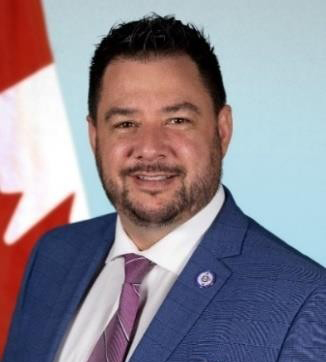
Name: Patrick Boucher
Title: Senior Assistant Deputy Minister
Telephone number: (613) 946-4884
Overview
Indigenous Services Canada works with First Nations, Inuit, other federal departments and provincial and territorial partners to support healthy First Nation and Inuit individuals, families and communities. Working with partners, the Branch strives to improve health outcomes, provide access to quality health services and support greater control of the health system by First Nations and Inuit.
Subjects
- Coronavirus and Indigenous communities
- Indigenous health care in Canada
- Diseases that may affect First Nations and Inuit communities
- Indigenous mental health and substance use
- Non-Insured Health Benefits for First Nations and Inuit
- Co-developing distinctions-based Indigenous health legislation
- Health care services for First Nations and Inuit
- Family Health
- Environmental issues and Indigenous health
In recent years, First Nations and Inuit health has improved; however, gaps remain in the overall health status of First Nation and Inuit when compared to other Canadians. ISC's FNIHB works with numerous partners to carry out many activities aimed at helping people stay healthy and promoting wellness.
On this shared path to improved health, the Branch funds or delivers:
- Community-based health promotion and disease prevention programs;
- Primary, home and community care services;
- Programs to control communicable diseases and address environmental health issues; and
- Non-insured health benefits to supplement those provided by provinces, territories; and private insurer.
Regional Operations, First Nations and Inuit Health Branch
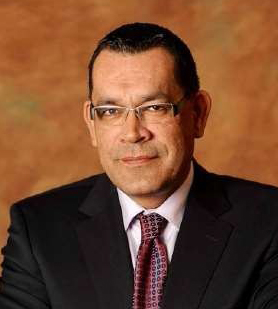
Name: Keith Conn
Title: Assistant Deputy Minister
Telephone number: (613) 204-8698
FNIHB Regional Executives
Atlantic Region

Name: Louis Dumulon
Title: Regional Executive
Telephone number: (613) 946-8104
Quebec Region

Name: Katrina Peddle
Title: Regional Executive
Telephone number: (514) 260-2058
Ontario Region

Name: Garry Best
Title: Regional Executive
Telephone number: (343) 550-6846
Manitoba Region

Name: Pam Smith
Title: Regional Executive
Telephone number: (204) 612-9248
Saskatchewan Region

Name: Jocelyn Andrews
Title: Regional Executive
Telephone number: (306) 203-4580
Alberta Region
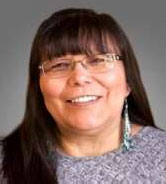
Name: Rhonda Laboucan
Title: Regional Executive
Telephone number: (780) 495-6459
Northern Region

Name: Heather MacPhail
Title: A/Regional Executive
Telephone number: (613) 301-5984
Child and Family Services Reform

Name: Catherine Lappe
Title: Assistant Deputy Minister
Telephone number: (604) 340-7703
Overview
In March 2018, ISC created the Child and Family Services Reform Sector in order to address the over-representation of Indigenous children and youth in care in Canada. The Sector is guided by the government's commitment to six points of action following a two-day Emergency Meeting on Indigenous Child and Family Services held in
January 2018 with Indigenous partners, provincial and territorial representatives, youth, experts and advocates:
- continuing to fully implement the orders from the Canadian Human Rights Tribunal, and reform First Nations child and family services program to make it truly child-centered and community-directed;
- working with partners to shift the focus of programming to culturally appropriate prevention, early intervention, and family reunification;
- supporting communities to exercise jurisdiction and working with partners to implement child and family services legislation;
- accelerating the work at tripartite and technical tables that are in place across the country to support reform;
- supporting Inuit and Métis Nation leadership in their work to advance meaningful, culturally appropriate reform of child and family services; and
- developing a data and reporting strategy with provinces, territories and Indigenous partners.
The Child and Family Services Reform Sector ensures the full implementation of the orders by the Canadian Human Rights Tribunal related to child and family services, and works with partners on implementing the co-developed An Act respecting First Nations, Inuit and Métis children, youth and families, which came into force on January 1, 2020.
Education and Social Development Programs and Partnerships

Name: David Peckham
Title: Assistant Deputy Minister
Telephone number: (613) 894-4239
Overview
The Education and Social Development Programs and Partnerships Sector is responsible for social and education programs.
The Sector works to strengthen both policy and program management functions, including program compliance and national consistency, and to monitor program performance and effectiveness for two of ISC's largest program areas: Education and Social Development.
The Sector's mandate is twofold:
- to provide First Nation men, women, children and families with the supports necessary to help them achieve education outcomes comparable to those of other Canadians; and
- to assist eligible on-reserve residents to foster greater self-reliance, improve quality of life, reduce or eliminate family violence, and participate more fully in Canada's economic opportunities.
The Sector is closely linked with eight regional offices (seven South of 60° and one in the Yukon) and the Regional Operations Sector.
Education related programs and services are delivered in collaboration with partners including First Nations regional education organizations and provinces. Other federal departments, particularly Human Resources and Skills Development Canada, are also partners in funding and delivering education-related programs and services.
Social programs and services are delivered in collaboration with First Nation organizations, provinces, territories and other federal departments. These partners includes: Health Canada, Human Resources and Skills Development Canada, Canada Mortgage and Housing Corporation, the Public Health Agency of Canada, provincial and territorial governments, the Assembly of First Nations, and others.
Strategic Policy and Partnership

Name: Gail Mitchell
Title: Assistant Deputy Minister
Telephone number: (613) 608-5029
Overview
The Strategic Policy and Partnerships Sector of ISC was established to support ISC sectors in the improvement and transfer of Indigenous services to Indigenous Peoples, for Indigenous Peoples, by Indigenous Peoples. The Strategic Policy and Partnerships Sector serves as an internal driver of change by supporting ISC sectors in improving services and enabling Indigenous control.
The Sector includes the following branches:
Strategic Policy
- Provides strategic policy analysis and advice in fulfillment of the Minister's mandate, ISC's transformation agenda, and federal policy direction.
Evaluation and Policy Re-Design
- Identifies innovative policy interventions and partnerships to improve and transfer services, and evaluate the success of transferred services through an Indigenous lens.
Strategic Research and Data Innovation
- Provides a robust and innovative evidence base for decision making to ensure that new and redesigned policy initiatives reflect Indigenous ways of knowing and doing. Examines long-term trends and undertake forecasting to keep ahead of emerging issues and identify challenges and opportunities.
Fiscal Arrangements
- Works to address longstanding challenges in how Indigenous services are funded and how funding relationships are managed with a long-term agenda.
Lands and Economic Development

Name: Dr. Kelley Blanchette
Title: Assistant Deputy Minister
Telephone number: (613) 447-2462
Overview
The Lands and Economic Development Sector manages a suite of programs, legislation and relationships with Indigenous organizations that together promote entrepreneurship, build economic development capacity and foster the creation of wealth. Lands and Economic Development also leads the administration of reserve land and supports environmental protection on reserve, both critical elements related to stimulating economic development.
Lands and Economic Development consists of three branches: Economic Policy Development Branch, which provides policy options/direction and coordination for the sector; Economic Business Opportunities, which administers proposal-driven programs for economic development projects; and Lands and Environmental Management, which works with First Nations and First Nation organizations on the administration of lands, the expansion of reserve lands through additions to reserve, the remediation of contaminated sites and the management of waste sites on-reserve. Lands and Economic Development also oversees a special operating agency (Indian Oil and Gas Canada), responsible for the management and regulation of oil and gas development of reserve lands.
The Sector also works with institutions, such as the Lands Advisory Board and the First Nations Land Management Resource Centre to improve First Nations lands and environmental governance, and leads lands modernization initiatives to improve existing legislation and regulations. Additionally, the Sector undertakes research and analysis to support policy development, fosters partnerships with stakeholders and coordinates a whole-of-government approach on Indigenous economic development. All sector efforts contribute to the ultimate goal of increasing the participation of Indigenous Peoples in the economy.
Regional offices across Canada implement Lands and Economic Development's programming and services and carry out the administration of the Crown's statutory and fiduciary obligations under the Indian Act. While the regions get their direction from Lands and Economic Development in terms of the activities that they perform to promote lands and economic development, they formally report to the Regional Operations Sector.
Corporate Secretariat

Name: Lana Thomas
Title: A/Corporate Secretary
Telephone number: (613) 799-1476
Overview
The Corporate Secretariat provides executive services to the Minister's Office, the Deputy Ministers' Offices, the Associate Deputy Ministers' Offices, as well as delivering key corporate functions across ISC. The Secretariat supports ISC on four key areas::
Executive Services Operations: comprised of three divisions responsible for coordinating and reviewing correspondence and briefing materials for the Deputy Ministers and the Minister:
- Officials Trips Directorate (MinTrips): works with the Minister's Offices, sectors, regions and Communications to ensure horizontal coordination of Ministerial trip planning. Ensures a strategic, coherent, and consistent approach in the development of material for, and in follow up to trips;
- Ministerial Correspondence Directorate: reviews and provides final quality control for briefing notes and correspondence to the Minister and Deputy Ministers, as well as oversight for departmental processes and practices associated with correspondence; and
- Governance and Planning Coordination: responsible for the coordination of material for ministerial briefings, invitations, transition, portfolio coordination, and final documentation preparation for additions to reserve.
Planning and Resource Management Directorate: responsible for providing administrative support services for the Minister's Office, Deputy Ministers' Offices, and the Corporate Secretariat, including business planning, finance, human resources, and contracting services.
Indigenous Employee Secretariat
Supports the work done by Indigenous Advisory Circles and Indigenous employee networks and serves as an information centre through which Indigenous and non-Indigenous employees can enquire about various Indigenous related programs, initiatives and events.
Access to Information and Privacy Directorate (shared service with Crown-Indigenous Relations and Northern Affairs Canada): receives all access to information and privacy requests and, working with sectors and regions, compiles the appropriate responses in accordance with the requirements of the Access to Information Act and Privacy Act.
5. Profiles of Shared Services Senior Executives
Legal Services Unit

Name: Marie Bourry
Title: Senior General Counsel
Telephone Number: (819) 953-0170
Overview
The Legal Services Unit provides a complete range of specialized legal advice and support to both Indigenous Services Canada (ISC) and Crown-Indigenous Relations and Northern Affairs Canada (CIRNAC) in relation to all their business lines. This includes legislative initiatives, litigation, policies and programs.
The Legal Services Unit is located at Headquarters in Gatineau, while its Treaties and Aboriginal Government-Negotiations West Section is located in Vancouver. The Legal Services Unit is part of the Aboriginal Affairs Portfolio of the Department of Justice Canada.
The Senior General Counsel is a full member of the ISC's Executive Committee and various management committees and, as such, provides legal advice as well as legal policy and strategic policy advice. As the Head of the Legal Services Unit, the Senior General Counsel brings forward legal concerns and advice around risk management relating to matters within ISC and CIRNAC's purview. The Senior General Counsel is the primary interface between ISC and CIRNAC and the Department of Justice Canada.
Counsel in the Legal Services Unit assess the legal risk of specific initiatives within the broader policy context, identify solutions to legal issues and work with departmental officers to develop strategies to address real or potential legal issues.
Human Resources and Workplace Services Branch

Name: Maryse Lavigne
Title: Director General
Telephone Number: (819) 994-7398
Overview
The Human Resources and Workplace Services Branch provides services, advice and support to both ISC and CIRNAC in the areas of Human Resources Management; Security and Accommodations; Occupational Health and Safety; and Integrity, Values and Ethics and Conflict Resolution.
Good people management is the cornerstone to delivering the ISC and CIRNAC mandates. While Deputy Ministers have the primary responsibility for ensuring good people management, the accountability is sub-delegated to managers across their organizations.
Key people management priorities include:
- continuing work on blueprint 2020 and the renewal of the Public Services;
- providing healthy workplaces conducive to employee engagement and excellence;
- addressing mental health stigma; and
- responding to Public Service Employee Surveys.
The workforce issues and opportunities at ISC and CIRNAC resemble those of other large departments. For instance, issues facing some employees with respect to the implementation of the Phoenix system across the Public Service remain a key challenge. The Branch is keeping track of the unresolved cases and has put a team to follow up with Public Service and Procurement Canada officials to address them.
What is unique to ISC and CIRNAC is the need to recruit and retain Indigenous employees and those in the North. Employee engagement is important across all occupations categories, across all regions, and has an effect on achieving departmental objectives. Addressing workplace issues and opportunities will ensure that we have the right working conditions for employees in a high performing organization and generate high employee engagement and productivity.
Communications

Name: Aruna Sadana
Title: Director General
Telephone Number: (613) 297-3311
Overview
Public perception of the government's handling of Indigenous issues is shaped by Canada's long, complicated and sometimes difficult relationship with Indigenous Peoples.
The Communications Branch acts as an advisor to colleague departments' Communications branches on Indigenous topics and convened an interdepartmental working group on reconciliation in order to coordinate messages across departments for a whole of government perspective. The Branch also supports the Prime Minister's Office and the Privy Council Office on Indigenous files.
The Communications Branch operates as an integrated corporate function. There is constant and close collaboration with the Minister's Office and the Office of the Deputy Minister to ensure that the Minister's and ISC's objectives, programs, services, and policies are communicated in a coherent way.
The Communications Branch reports directly to the Deputy Minister and is headed by a Director General with the support of a Senior Director and two Directors. While the Communications Branch continues to transform into two distinct Communication branches (one for ISC and one for CIRNAC), many Communications functions remain joint between both ISC and CIRNAC.
Audit

Name: Stephanie Barozzi
Title: Chief Audit and Evaluation Executive
Telephone Number: (613) 218-9112
Overview
Stephanie Barozzi is the Chief Audit Executive (CAE) for ISC and the Chief Audit and Evaluation Executive for CIRNAC. In this role, she has the responsibility for internal audit for both departments, while Gail Mitchell, Assistant Deputy Minister, Strategic Policy and Partnerships Sector, has the responsibility for evaluation within ISC.
The Chief Audit Executive for ISC leads the audit, risk management, and assessment and investigation functions within ISC. The Chief Audit Executive provides the Deputy Minister with independent advice on matters of risk management, control and governance. The Chief Audit Executive consults senior management on the development of ISC's Risk-Based Audit Plan on an annual basis and as required throughout the year. The plan guides the audit work conducted in accordance with Treasury Board policies, resulting in reports that are provided to the Deputy Minister for approval. The Chief Audit Executive also serves as a point of contact for audit work conducted in ISC by external assurance providers, such as the Office of the Auditor General and Treasury Board Secretariat. In addition, the Chief Audit Executive serves as ISC's Chief Risk Officer and oversees the development of the Corporate Risk Profile. Strategic advice is provided to the Deputy Minister on transformation initiatives that include a Transformation Risk Assessment.
The Audit Committee, chaired by and composed of external members, receives and provides strategic advice to the Deputy Minister. The Committee advises on audit reports, follow up for both internal audits and Auditor General chapters, government-wide audits and action plans to address audit findings.
The Audit and Assurance Services Branch conducts independent audits and consulting projects of ISC's programs, services, management practices and controls. A Risk-based Audit Plan is developed annually. The Branch provides ISC with liaison support when external assurance providers audit ISC.
The Assessment and Investigation Services Branch is the designated focal point of complaints, allegations of fraud pertaining to ISC's funding, and conducts forensic audits to ensure that funds are not misused.
The Risk Management and Communications Liaison Centre provides service and advice to ensure a continuous, proactive and systematic process to understand, manage and communicate risk.
6. Indigenous Services Canada 2021-2022 Financial Overview
October 2021
Purpose
- Provide a financial overview of Indigenous Services Canada (ISC) with a focus on 2021-2022 authorities to date, including:
- Main Estimates; and
- Supplementary Estimates A.
- Highlight key COVID-19 response measures and associated expenditures.
- Provide departmental expenditure trends by Program Area.
Overview
- ISC works collaboratively with partners to improve access to high quality services for First Nations, Inuit and Métis, with a long-term objective of advancing work to close socio-economic gaps and advance self-determination.
- 2021-2022 total authorities amount to $18.9 billion. Most expenditures are associated with the delivery of core and essential services and the response to the COVID-19 global pandemic.
- Key priority areas include:
- education
- social development
- children and families
- health
- infrastructure
- economic prosperity
- Through the implementation of the 10-year grant (co-developed with First Nations partners), ISC continues to support the Government of Canada's commitment in building a new fiscal relationship with First Nations that results in sufficient, predictable and sustained funding.
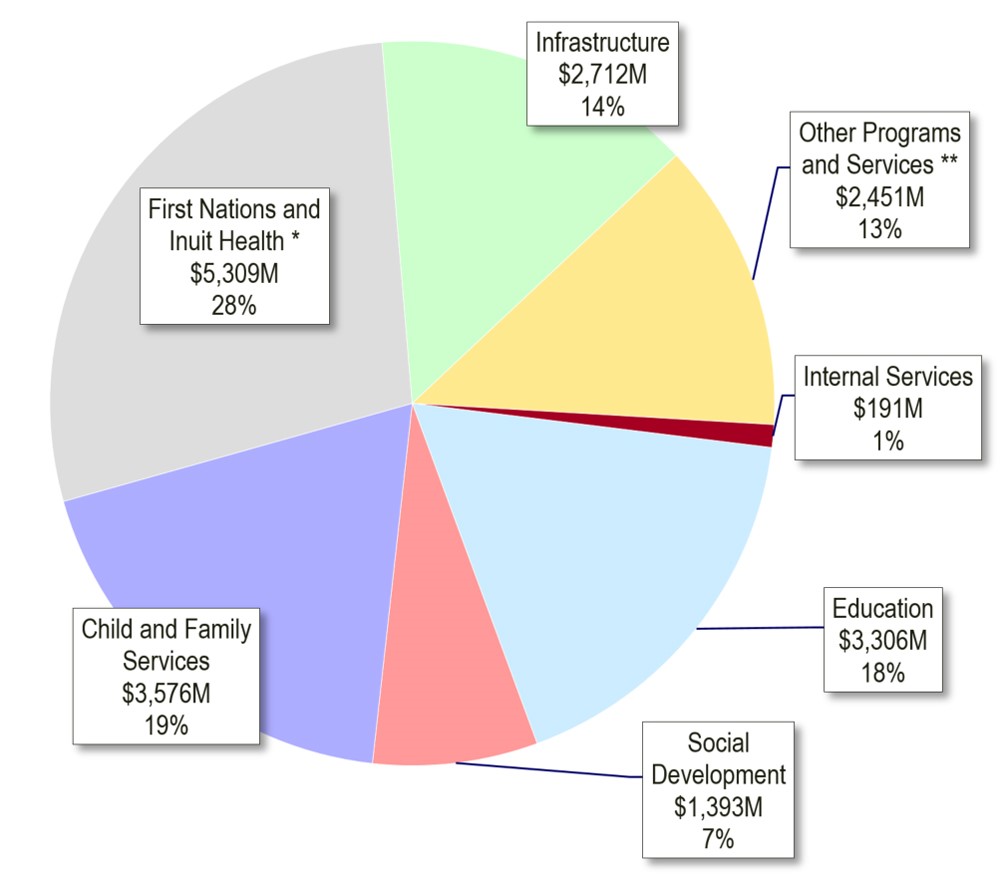
Text alternative for Overview of expenditures at ISC
This pie chart shows the breakdown of expenditures ($18.9 billion) at ISC. The breakdown is shown as follows:
- $5,309 million (28%) First Nations and Inuit Health (including Jordan's Principle)
- $3,576 million (19%) child and family services
- $3,306 million (18%) education
- $2,712 million (14%) infrastructure
- $2,451 million (13%) other programs and services (including Indigenous Governance and Capacity, Land and Economic Development Related Programs, Individual Affairs, Emergency Management Assistance, and Urban Programming for Indigenous Peoples)
- $1,393 million (7%) social development
- $191 million (1%) internal services
Figures above have been adjusted to include funding provided under the "New Fiscal Relationship" Grant and Self-Determined Services.
* Including Jordan's Principle
** Other Programs and Services include: Indigenous Governance and Capacity, Land and Economic Development Related Programs, Individual Affairs, Emergency Management Assistance, and Urban Programming for Indigenous Peoples.
Figures above have been adjusted to include funding provided under the "New Fiscal Relationship" Grant and Self-Determined Services
Source: 2021-2022 Authorities to Date as per Supplementary Estimates (A).
Figures may not add due to rounding.
Expenditures by Departmental Results Framework
2021–2022 Authorities to Date – $18,939 million
Internal Services 191 1.0% (in millions of dollars)
| Services and Benefits to Individuals | 2,036 | 10.8% |
|---|---|---|
| Supplementary Health Benefits | 1,588 | 8.4% |
| Clinical and Client Care | 380 | 2.0% |
| Community Oral Health Services | 28 | 0.1% |
| Individual Affairs | 42 | 0.2% |
| Health and Social Services | 9,623 | 50.8% |
|---|---|---|
| Jordan's Principle | 454 | 2.4% |
| Mental Wellness | 531 | 2.8% |
| Healthy Living | 65 | 0.3% |
| Healthy Child Development | 170 | 0.9% |
| Home and Community Care | 185 | 1.0% |
| Health Human Resources | 3 | 0.0% |
| Environmental Public Health | 72 | 0.4% |
| Communicable Disease Control and Management | 691 | 3.6% |
| Education | 2.455 | 13.0% |
| Income Assistance | 827 | 4.4% |
| Assisted Living | 138 | 0.7% |
| First Nations Child and Family Services | 3,576 | 18.9% |
| Family Violence Prevention | 68 | 0.4% |
| Urban Programming for Indigenous Peoples | 388 | 2.0% |
| Governance and Community Development Services | 4,666 | 24.6% |
|---|---|---|
| Health Facilities | 182 | 1.0% |
| e-Health Infostructure | 28 | 0.1% |
| Health Planning, Quality Management and Systems Integration | 159 | 0.8% |
| Indigenous Governance and Capacity | 342 | 1.8% |
| Water and Wastewater | 1,228 | 6.5% |
| Education Facilities | 174 | 0.9% |
| Housing | 139 | 0.7% |
| Other Community Infrastructure and Activities | 901 | 4.8% |
| Emergency Management Assistance | 547 | 2.9% |
| Indigenous Entrepreneurship and Business Development | 133 | 0.7% |
| Economic Development Capacity and Readiness | 543 | 2.9% |
| Land, Natural Resources and Environmental Management | 285 | 1.5% |
| Statutory, Legislative and Policy Support to First Nations Governance | 4 | 0.0% |
| Indigenous Self-Determined Services | 2,422 | 12.8% |
|---|---|---|
| New Fiscal Relationship | 1,559 | 8.2% |
| Self-Determined Services | 285 | 1.5% |
| British Columbia Tripartite Health Governance | 578 | 3.1% |
Source: 2021-2022 Authorities to Date as per Supplementary Estimates (A)
Figures may not add due to rounding.
Service Delivery at ISC
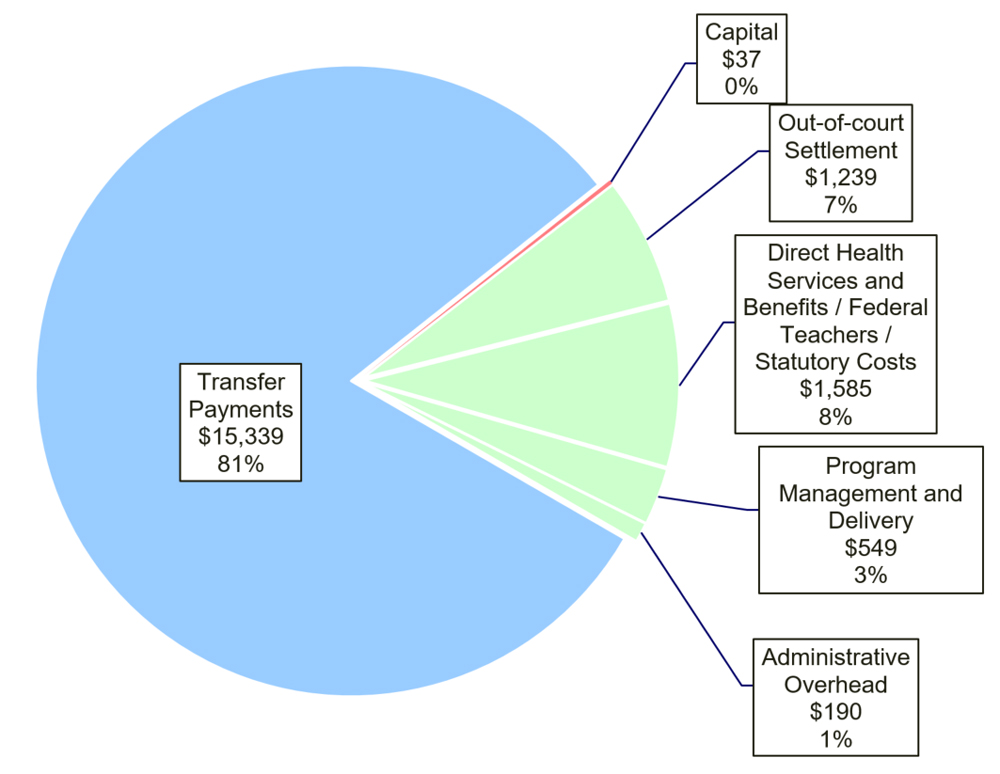
Text alternative for Authorities by Category ($M)
This pie chart shows the breakdown of expenditures by category. The breakdown is shown as follows:
- $15,339 million (81%) transfer payments
- $37 million (0%) capital, $1,239 million (7%) out-of-court settlement
- $1,585 million (8%) direct health services and benefits / federal teachers / statutory costs
- $549 million (3%) program management and delivery
- $190 million (1%) administrative overhead
| Operating Total = $3,563M | Transfer Payment Total = $15,339M | ||
|---|---|---|---|
| Comprised of: | Comprised of: | ||
| Vote 1 – Operating expenditures | 3,467 | Vote 10 – Grants and Contributions | 15,276 |
| (S) Employee benefit plans | 94 | (S) Indian Annuities Treaty payments | 2 |
| (S) Loan guarantees | 2 | (S) Canada Community-Building Fund | 61 |
| Total | $3,563 | Total | $15,339 |
| Capital Total = $37M (Vote 5 Capital Expenditures) | |||
Source: 2021-2022 Authorities to Date as per Supplementary Estimates (A)
Figures may not add due to rounding.
- Approximately 89% of resources are used to support or deliver services to Indigenous Peoples, communities and organizations.
- 81% through transfer payments to fund services delivered by First Nations community governments, Tribal Councils, health authority, etc.
- Most funds are for basic provincial/municipal type services to individuals on-reserve. The government is committed to provide levels of services that are comparable to those typically provided by provinces.
- Provincial standards guide program delivery leading to variability across regions.
- Various funding mechanisms are used to allow for greater flexibility for the recipients, including the New Fiscal Relationship grant, which commits funding over a ten-year period.
- Eight percent through operating to fund health-related goods and services not insured by provinces and territories or other private insurance plans. ISC also employs nurses, health professionals and teachers to directly provide various health and education services.
- 81% through transfer payments to fund services delivered by First Nations community governments, Tribal Councils, health authority, etc.
Authorities and Full-time Equivalents by Regions
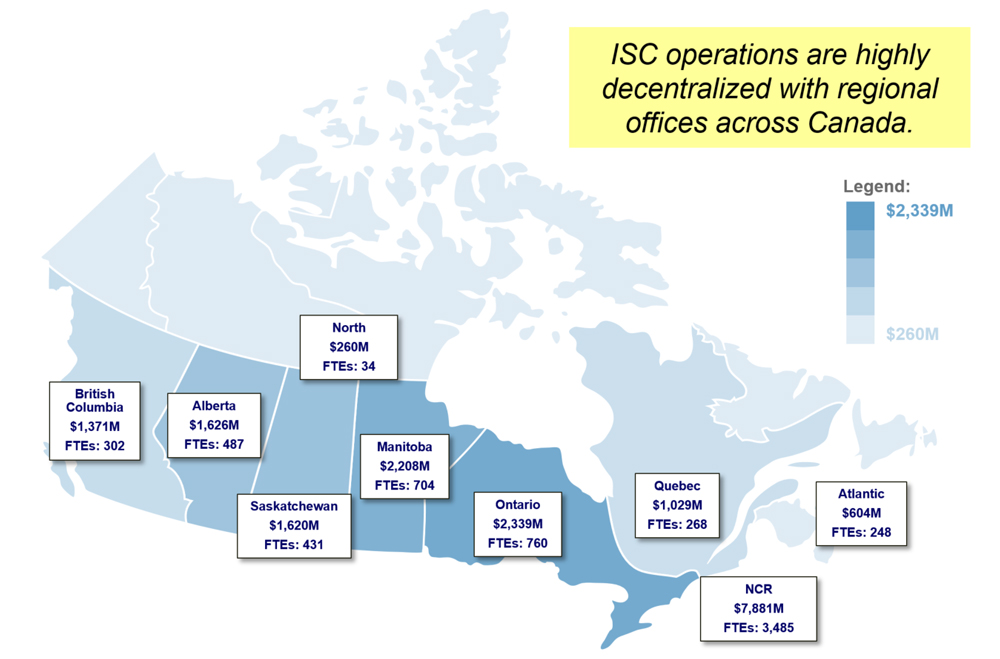
Text alternative for Authorities and Full-time Equivalents by Regions
This map shows the breakdown of expenditures and FTEs by regions. The breakdown is shown as follows:
- $1,371 million and 302 FTEs for British Columbia
- $1,626 million and 487 FTEs for Alberta
- $260 million and 34 FTEs for North
- $1,620 million and 431 FTEs for Saskatchewan
- $2,208 million and 704 FTEs for Manitoba
- $2,339 million and 760 FTEs for Ontario
- $1,029 million and 268 FTEs for Quebec
- $7,881 million and 3,485 FTEs for National Capital Region (NCR)
- $604 million and 248 FTEs for Atlantic.
Some of NCR funding will be allocated to the regions throughout the year. Based on this, ISC operations are highly decentralized with regional offices across Canada.
FTEs reflect the personnel working on the region's file, not the physical location, e.g. the Northern region has FTEs located in NCR.
Figures may not add due to rounding.
Full-time equivalents (FTEs) reflect the personnel working on the Region's file, not the physical location, e.g. the northern region has FTEs located in the National Capital Region (NCR).
Figures may not add due to rounding.
COVID-19 Initiatives
| COVID-19 Measures | Budget | Actuals |
|---|---|---|
| Canada's initial response to COVID-19 | $10,000,000 | $9,998,735 |
| Communications and Marketing | $300,000 | $300,000 |
| Emergency Food Security Fund | $30,000,000 | $29,973,830 |
| Enhance public health responses to COVID-19 in First Nations and Inuit communities - Wave 1 | $277,881,716 | $277,881,716 |
| Enhance public health responses to COVID-19 in First Nations and Inuit communities - Wave 2 | $1,143,276,251 | $452,459,125 |
| Funding for Indigenous communities affected by disruptions to their revenues, which are necessary to support programs and services (COVID-19) | $332,205,592 | $1,130,000 |
| Funding for the continuation of public health responses in Indigenous communities (COVID-19) – Health Human Resources | $91,316,377 | $11,565,141 |
| Funding to improve ventilation in public buildings (COVID-19) (horizontal item) | $18,650,840 | $129,998 |
| Income Assistance | $262,469,907 | $262,175,766 |
| Indigenous Community Support Fund - Wave 1 | $304,999,999 | $304,999,999 |
| Indigenous Community Support Fund - Wave 2 | $304,999,939 | $304,999,939 |
| Indigenous Community Support Fund - Wave 3 | $417,387,226 | $375,735,566 |
| Indigenous Community Support Fund - Wave 4 | $760,000,000 | $191,739,007 |
| Indigenous mental wellness | $82,427,994 | $82,427,994 |
| Safe restart in Indigenous communities | $381,243,840 | $274,003,027 |
| Students and youth | $180,603,928 | $116,517,131 |
| Support for Indigenous Businesses and Aboriginal Financial Institutions | $369,929,560 | $264,397,440 |
| Support for Local Indigenous Businesses and Economies | $247,600,000 | $168,173,756 |
| Support for Women's Shelters and Sexual Assault Centres, including in Indigenous Communities | $10,000,000 | $10,000,000 |
| Supportive care in Indigenous communities | $118,110,064 | $10,960,548 |
| Urban and regional Indigenous organizations | $75,000,000 | $75,000,000 |
| Grand Total | $5,418,403,233 | $3,224,568,717 |
- As of July 30, 2021, ISC has spent $3.2 billion in COVID-19 response initiatives. $2.8 billion was spent in 2020-2021 and $433.1 million in 2021-2022 over a total budget of $5.4 billion, for 2020-2021 and 2021-2022.
- Since the beginning of the pandemic, ISC has utilized available flexibilities to expedite response measures by reallocating program financial resources, maximizing coverage of program Terms and Conditions, providing further flexibility to communities in the ir use of funds, as well as gaining access to additional federal funds to address emergency support needs.
- ISC continues to work closely with the Public Health Agency of Canada, other Government of Canada departments, and provincial and territorial governments as well as Indigenous partners to protect the health and safety of Indigenous Peoples.
Expenditure Trend
- In 2021-2022, approximately 86% of ISC expenditures are focused on five major areas: Education, Social Development; Child and Family Services; First Nations and Inuit Health; and Infrastructure.
- Expenditures have significantly increased over the years in key areas (e.g., Child and Family Services, Health, Safe and clean drinking water) and reflect the COVID-19 response for the period 2020-2022
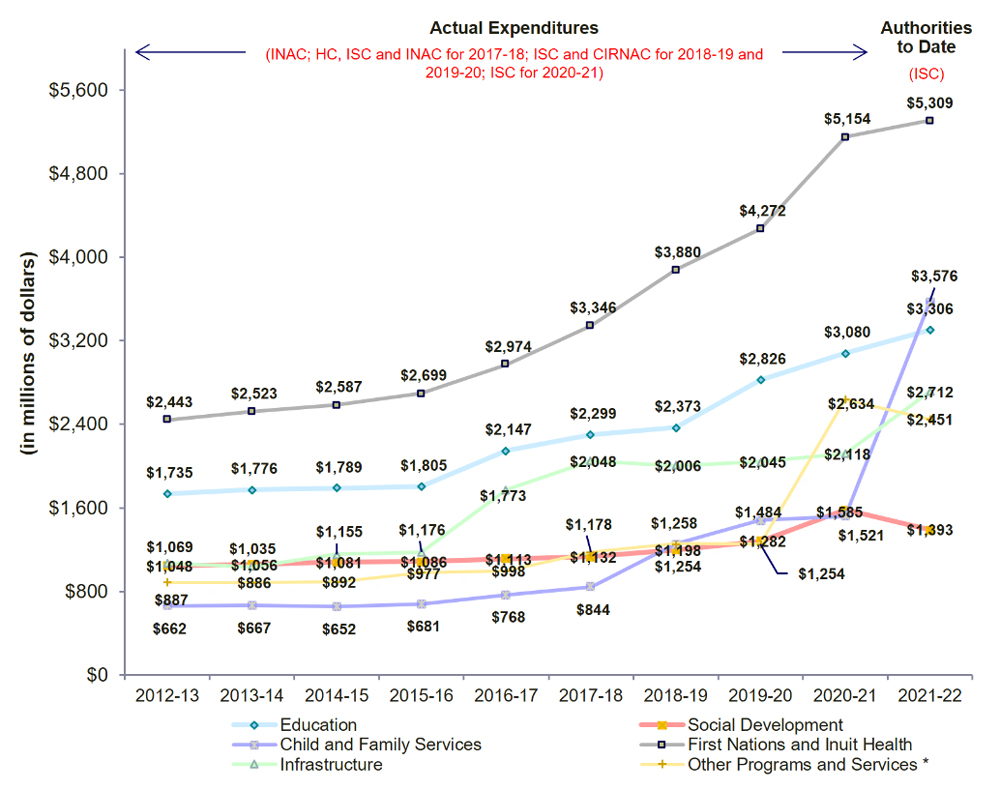
Text alternative for Expenditure Trend
This chart shows the breakdown of expenditures trend by major areas from 2012-13 to 2021-22. It demonstrates that about 86% of ISC expenditures are in 2021-22 for five major areas: Education, Social Development, Child and Family Services, First Nations and Inuit Health, and Infrastructure.
Numerical values presented on the image:
| Millions of dollars | Actual Expenditures (INAC; HC, ISC and INAC for 2017-18; ISC and CIRNAC for 2018-19 and 2019-20; ISC for 2020-21) |
Authorities to Date (ISC) | ||||||||
|---|---|---|---|---|---|---|---|---|---|---|
| Fiscal Year | 2012-13 | 2013-14 | 2014-15 | 2015-16 | 2016-17 | 2017-18 | 2018-19 | 2019-20 | 2020-21 | 2021-22 |
| Education | 1,735 | 1,776 | 1,789 | 1,805 | 2,147 | 2,299 | 2,373 | 2,826 | 3,080 | 3,306 |
| Social Development | 1,048 | 1,056 | 1,081 | 1,086 | 1,113 | 1,132 | 1,198 | 1,282 | 1,585 | 1,393 |
| Child and Family Services | 662 | 667 | 652 | 681 | 768 | 844 | 1,254 | 1,484 | 1,521 | 3,576 |
| First Nations and Inuit Health | 2,443 | 2,523 | 2,587 | 2,699 | 2,974 | 3,346 | 3,880 | 4,272 | 5,154 | 5,309 |
| Infrastructure | 1,069 | 1,035 | 1,155 | 1,176 | 1,773 | 2,048 | 2,006 | 2,045 | 2,118 | 2,712 |
| Other Programs and Services * | 887 | 886 | 892 | 977 | 998 | 1,178 | 1,258 | 1,250 | 2,634 | 2,451 |
* Other Programs and Services include: Indigenous Governance and Capacity, Land and Economic Development Related Programs, Individual Affairs, Emergency Management Assistance, Urban Programming for Indigenous Peoples, and New Fiscal Relationship - others.
Source: 2012-2013 to 2020-2021 figures are based on restatement of expenditures reported in Departmental Performance Reports/Departmental Results Report for INAC, Health Canada, CIRNAC and ISC. 2021-2022 Authorities to Date as per Supplementary Estimates (A).
Note: 2020-2021 Departmental Results Report and Public Accounts have not been published.
Figures may not add due to rounding.
Expenditure Trend – Education (Annex A)
- Overall, actual expenditures for education have increased by about 77.6% over the period 2012-2013 to 2020-2021.
- The major increase observed from 2015-2016 to 2019-2020 is primarily due to investments in First Nations elementary and secondary education provided by Budget 2016.
- The increase in 2020-2021 and 2021-2022 is primarily due to additional funding for education programs and COVID-19 measures for:
- supporting students and youth; and
- supporting a safe restart in Indigenous communities.
- $566 million of funding is transferred from program contributions to the New Fiscal Relationship grant:
- $423 million from Elementary and Secondary Education; and
- $142 million from Post-Secondary Education.
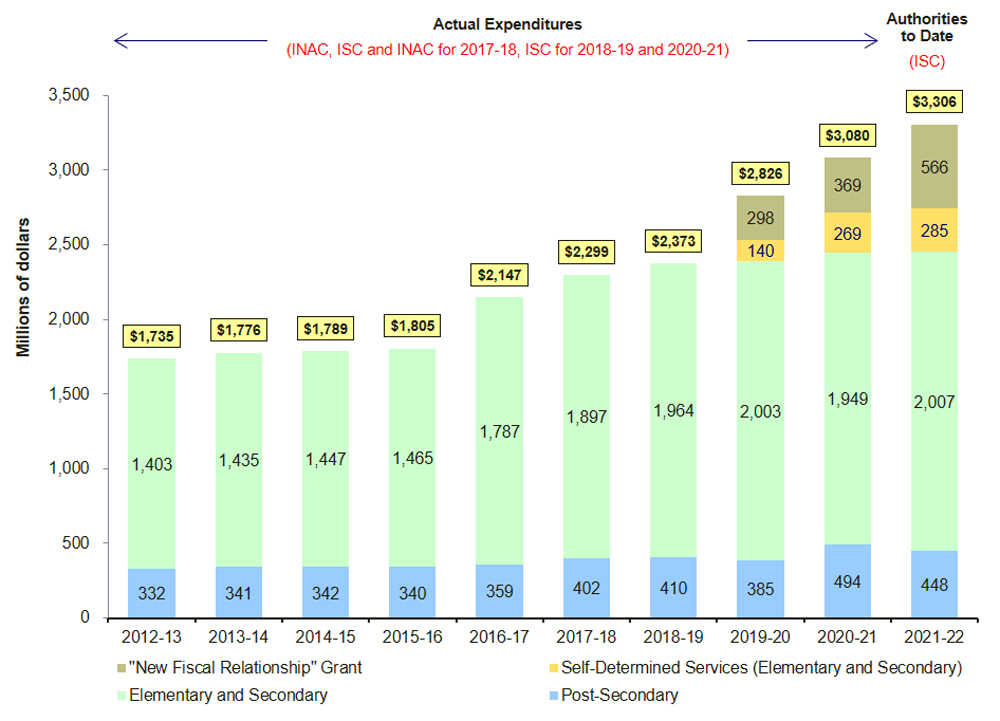
Text alternative for Expenditure Trend – Education
This chart shows the breakdown of expenditures trend for education from 2012-13 to 2021-22.
Numerical values presented on the image:
| Millions of dollars | Actual Expenditures (INAC, ISC and INAC for 2017-18, ISC from 2018-19 to 2020-21) |
Authorities to Date (ISC) | ||||||||
|---|---|---|---|---|---|---|---|---|---|---|
| Fiscal Year | 2012-13 | 2013-14 | 2014-15 | 2015-16 | 2016-17 | 2017-18 | 2018-19 | 2019-20 | 2020-21 | 2021-22 |
| "New Fiscal Relationship" Grant | N/A | N/A | N/A | N/A | N/A | N/A | N/A | 298 | 369 | 566 |
| Self-Determined Services (Elementary and Secondary) | N/A | N/A | N/A | N/A | N/A | N/A | N/A | 140 | 269 | 285 |
| Elementary and Secondary | 1,403 | 1,435 | 1,447 | 1,465 | 1,787 | 1,897 | 1,964 | 2,003 | 1,949 | 2,007 |
| Post-Secondary | 332 | 341 | 342 | 340 | 359 | 402 | 410 | 385 | 494 | 448 |
| Total | 1,735 | 1,776 | 1,789 | 1,805 | 2,147 | 2,299 | 2,373 | 2,826 | 3,080 | 3,306 |
Source: 2012-2013 to 2020-2021 as per Departmental Performance Reports/Departmental Results Report. 2021-2022 Authorities to Date as per Supplementary Estimates (A).
Note: 2020-2021 Departmental Results Report and Public Accounts have not been published.
Figures may not add due to rounding.
Expenditure Trend – Social Development (Annex B)
- Overall, actual expenditures for social development have increased by about 51.2% over the period 2012-2013 to 2020-2021 (or by about 5.3% annually).
- The increase in 2020-2021 and 2021-2022 is primarily due to COVID-19 measures for:
- Income Assistance;
- supportive care in Indigenous communities;
- enhancing public health measures; and
- the Family Violence Prevention Program.
- $360 million of funding is transferred from program contributions to the New Fiscal Relationship grant:
- $324 million from Income Assistance; and
- $36 million from Assisted Living.
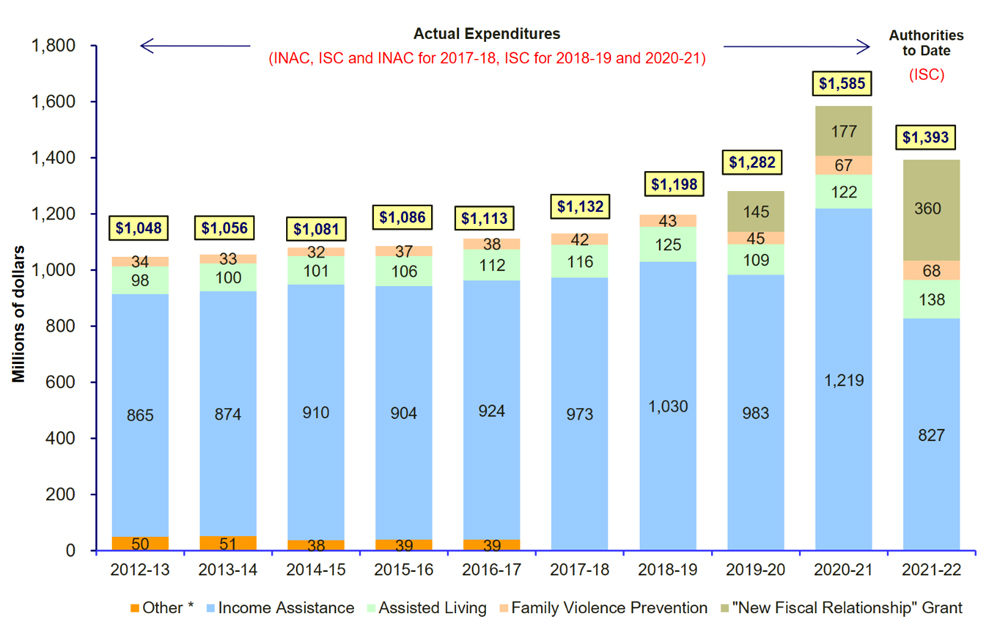
Text alternative for Expenditure Trend – Social Development
This chart shows the breakdown of expenditures trend for social development from 2012-13 to 2021-22. Numerical values presented on the image:
| Millions of dollars | Actual Expenditures (INAC, ISC and INAC for 2017-18, ISC for from 2018-19 to 2020-21) |
Authorities to Date (ISC) | ||||||||
|---|---|---|---|---|---|---|---|---|---|---|
| Fiscal Year | 2012-13 | 2013-14 | 2014-15 | 2015-16 | 2016-17 | 2017-18 | 2018-19 | 2019-20 | 2020-21 | 2021-22 |
| "New Fiscal Relationship" Grant | N/A | N/A | N/A | N/A | N/A | N/A | N/A | 145 | 177 | 360 |
| Family Violence Prevention | 34 | 33 | 32 | 37 | 38 | 42 | 43 | 45 | 67 | 68 |
| Assisted Living | 98 | 100 | 101 | 106 | 112 | 116 | 125 | 109 | 122 | 138 |
| Income Assistance | 865 | 874 | 910 | 904 | 924 | 973 | 1,030 | 983 | 1,219 | 827 |
| Other * | 50 | 51 | 38 | 39 | 39 | N/A | N/A | N/A | N/A | N/A |
| Total | 1,048 | 1,056 | 1,081 | 1,086 | 1,113 | 1,132 | 1,198 | 1,282 | 1,585 | 1,393 |
Source: 2012-2013 to 2017-2018 as per Indigenous and Northern Affairs Canada (INAC) Departmental Performance Reports/Departmental Results Reports; and 2017-2018 to 2020-2021 as per ISC Departmental Results Reports. Expenditure trends for INAC are included in this chart for the period 2012-2013 to 2017-2018 in order to provide comparative figures for ISC. For the period from 2012-2013 to 2013-2014, Family Capacity Initiatives are included in the Child and Family Services and beginning in 2014-2015, Family Capacity Initiatives are included in Income Assistance, pursuant to the revised Program Alignment Architecture.
* Starting in 2017-2018, the National Child Benefit sub-program has been removed and replaced by the new Canada Child Benefit, which is managed through Canada Revenue Agency.
Note: 2020-2021 Departmental Results Report and Public Accounts have not been published.
Figures may not add due to rounding.
Expenditure Trend – Child and Family Services (Annex C)
- Overall, actual expenditures for child and family services have more than doubled since 2012-2013.
- The increase in expenditures since 2015-2016 reflects urgent investments in the First Nations Child and Family Services Program.
- Additional funding is also provided starting 2020-2021 to implement An Act respecting First Nations, Inuit and Métis children, youth and families and the ongoing reform of Indigenous Child and Family Services program.
- The increase observed between 2020-2021 and 2021-2022 is mainly due to support increasing program needs and advance Canada's overall commitment to reconciliation by paving the way for a more respectful and constructive relationship with Indigenous Peoples and to support First Nations Child and Family Services, Canadian Human Rights
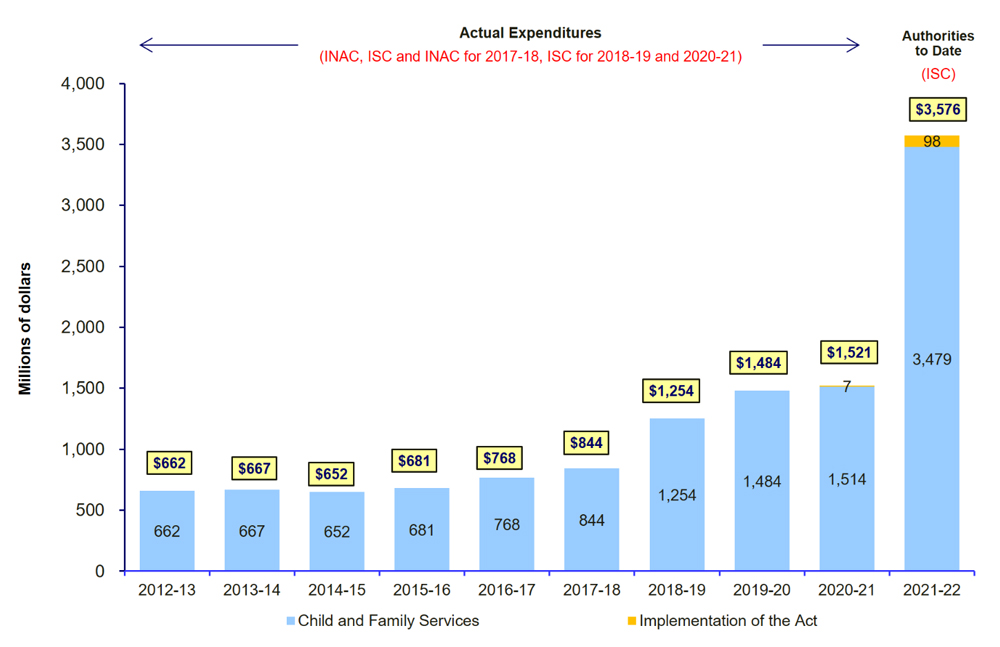
Text alternative for Expenditure Trend – Child and Family Services
This chart shows the breakdown of expenditures trend for child and family services from 2012-13 to 2021-22. Numerical values presented on the image:
| Millions of dollars | Actual Expenditures (INAC, ISC and INAC for 2017-18, ISC from 2018-19 to 2020-21) |
Authorities to Date (ISC) | ||||||||
|---|---|---|---|---|---|---|---|---|---|---|
| Fiscal Year | 2012-13 | 2013-14 | 2014-15 | 2015-16 | 2016-17 | 2017-18 | 2018-19 | 2019-20 | 2020-21 | 2021-22 |
| Child and Family Services | 662 | 667 | 652 | 681 | 768 | 844 | 1,254 | 1,484 | 1,514 | 3,479 |
| Implementation of the Act | N/A | N/A | N/A | N/A | N/A | N/A | N/A | N/A | 7 | 98 |
| Total | 662 | 667 | 652 | 681 | 768 | 844 | 1,254 | 1,484 | 1,521 | 3,576 |
Source: 2012-2013 to 2017-2018 as per INAC Departmental Performance Reports/Departmental Results Reports; and 2017-2018 to 2020-2021 as per ISC Departmental Results Reports. Expenditure trends for INAC are included in this chart for the period 2012-2013 to 2017-2018 in order to provide comparative figures for ISC. For the period from 2012-2013 to 2013-2014, Family Capacity Initiatives are included in the Child and Family Services and beginning in 2014-2015, Family Capacity Initiatives are included in Income Assistance, pursuant to the revised Program Alignment Architecture.
Note: 2020-2021 Departmental Results Report and Public Accounts have not been published.
Figures may not add due to rounding.
Expenditure Trend – First Nations and Inuit Health (Annex D)
- Expenditures increase observed from 2015-2016 to 2019-2020 primarily reflects significant investments provided by Budget 2016, 2017 and 2018 on Social Infrastructure, Non-Insured Health Benefits as well as increased spending on Nursing, Mental wellness and Jordan's Principle.
- The increase in 2020-2021 and 2021-2022 is mainly due to COVID-19 measures, such as:
- the continuation of public health responses in Indigenous communities;
- Indigenous mental wellness;
- supporting a safe restart in Indigenous communities; and
- for supportive care in Indigenous communities.
- $196 million of funding is transferred from program contribution to the New Fiscal Relationship grant:
- $148 million from Primary Health Care; and
- $48 million from Health
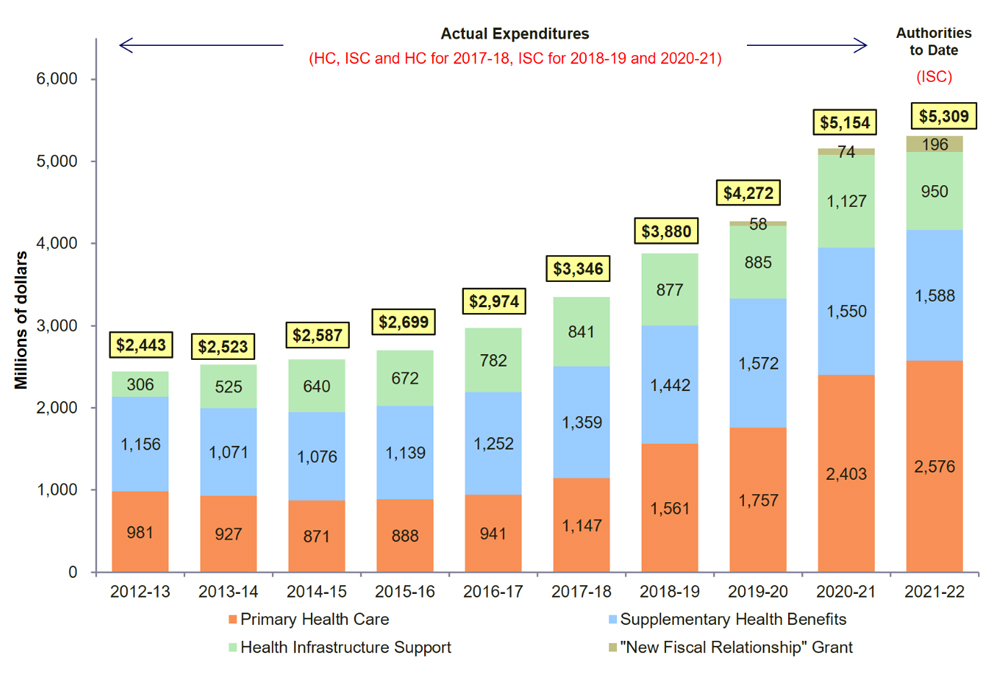
Text alternative for Expenditure Trend – First Nations and Inuit Health
This chart shows the breakdown of expenditures trend for First Nations and Inuit Health from 2012-13 to 2021-22. Numerical values presented on the image:
| Millions of dollars | Actual Expenditures (HC, ISC and HC for 2017-18, ISC from 2018-19 to 2020-21) |
Authorities to Date (ISC) | ||||||||
|---|---|---|---|---|---|---|---|---|---|---|
| Fiscal Year | 2012-13 | 2013-14 | 2014-15 | 2015-16 | 2016-17 | 2017-18 | 2018-19 | 2019-20 | 2020-21 | 2021-22 |
| "New Fiscal Relationship" Grant | N/A | N/A | N/A | N/A | N/A | N/A | N/A | 58 | 74 | 196 |
| Health Infrastructure Support | 306 | 525 | 640 | 672 | 782 | 841 | 877 | 885 | 1,127 | 950 |
| Supplementary Health Benefits | 1,156 | 1,071 | 1,076 | 1,139 | 1,252 | 1,359 | 1,442 | 1,572 | 1,550 | 1,588 |
| Primary Health Care | 981 | 927 | 871 | 888 | 941 | 1,147 | 1,561 | 1,757 | 2,403 | 2,576 |
| Total | 2,443 | 2,523 | 2,587 | 2,699 | 2,974 | 3,346 | 3,880 | 4,272 | 5,154 | 5,309 |
Source: 2012-2013 to 2017-2018 as per Health Canada Departmental Performance Reports/Departmental Results Reports; and 2017-2018 to 2020-2021 as per ISC Departmental Results Reports. Expenditure trends for Health Canada are included in this chart for the period 2012-2013 to 2017-2018 in order to provide comparative figures for ISC.
Note: 2020-2021 Departmental Results Report and Public Accounts have not been published.
Figures may not add due to rounding.
Expenditure Trend – Infrastructure (excluding Health Infrastructure) (Annex E)
- The increase observed from 2015-2016 to 2019-2020 primarily reflects significant investments provided by Budget 2016, 2017 and 2018 across all Infrastructure asset categories.
- The increase in 2020-2021 and 2021-2022 is primarily due to additional funding to improve access to safe, clean drinking water in First Nation communities; as well as COVID-19 measures, such as:
- enhancing public health measures in First Nations and Inuit communities;
- supporting a safe restart in Indigenous communities;
- Indigenous Community Support Fund; and
- Improving ventilation in public buildings.
- $271 million of funding is transferred from program contribution to the New Fiscal Relationship grant:
- $41 million from Housing;
- $48 million from Education Facilities;
- $125 million from Other Community Infrastructure and Activities; and
- $57 million from Water and Wastewater.
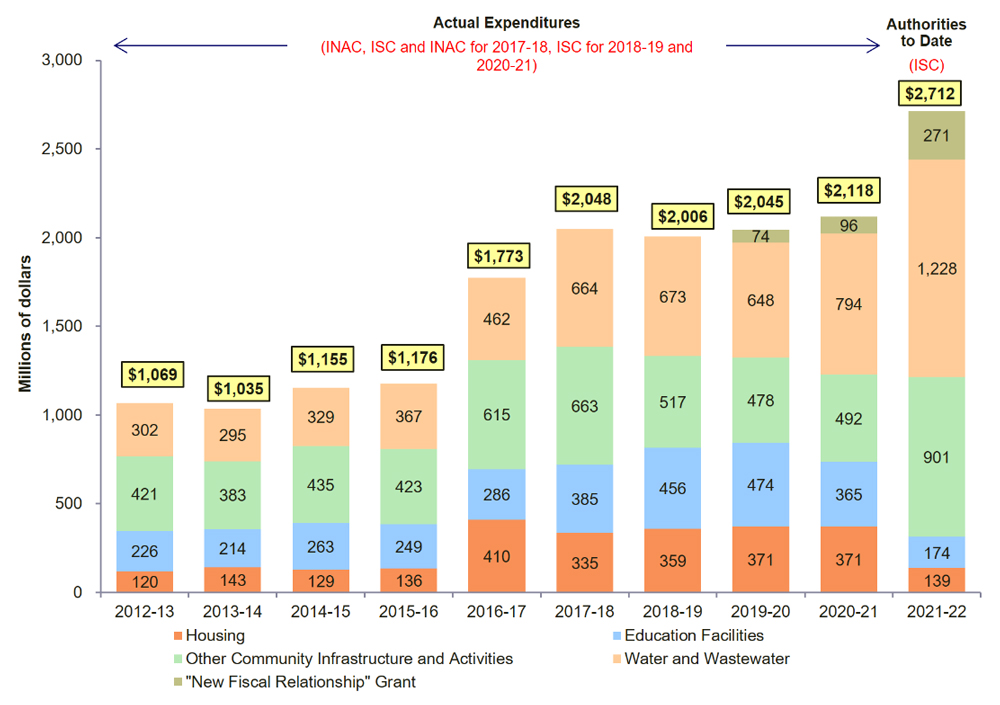
Text alternative for Expenditure Trend – Infrastructure
This chart shows the breakdown of expenditures trend for Infrastructure (excluding Health Infrastructure) from 2012-13 to 2021-22. Numerical values presented on the image:
| Millions of dollars | Actual Expenditures (INAC, ISC and INAC for 2017-18, ISC from 2018-19 to 2020-21) |
Authorities to Date (ISC) | ||||||||
|---|---|---|---|---|---|---|---|---|---|---|
| Fiscal Year | 2012-13 | 2013-14 | 2014-15 | 2015-16 | 2016-17 | 2017-18 | 2018-19 | 2019-20 | 2020-21 | 2021-22 |
| "New Fiscal Relationship" Grant | N/A | N/A | N/A | N/A | N/A | N/A | N/A | 74 | 96 | 271 |
| Water and Wastewater | 302 | 295 | 329 | 367 | 462 | 664 | 673 | 648 | 794 | 1,228 |
| Other Community Infrastructure and Activities | 421 | 383 | 435 | 423 | 615 | 663 | 517 | 478 | 492 | 901 |
| Education Facilities | 226 | 214 | 263 | 249 | 286 | 385 | 456 | 474 | 365 | 174 |
| Housing | 120 | 143 | 129 | 136 | 410 | 335 | 359 | 371 | 371 | 139 |
| Total | 1,069 | 1,035 | 1,155 | 1,176 | 1,773 | 2,048 | 2,006 | 2,045 | 2,118 | 2,712 |
Source: 2012-2013 to 2017-2018 as per INAC Departmental Performance Reports/Departmental Results Reports; and 2017-2018 to 2020-2021 as per ISC Departmental Results Reports. Expenditure trends for INAC are included in this chart for the period 2012-2013 to 2017-2018 in order to provide comparative figures for ISC.
Note: 2020-2021 Departmental Results Report and Public Accounts have not been published.
Figures may not add due to rounding.
Expenditure Trend – Other Programs and Services (Annex F)
- The increase in 2020-2021 and 2021-2022 is mainly due to COVID-19 measures, such as:
- Indigenous Community Support Fund;
- supporting Indigenous businesses;
- supportive care in Indigenous communities;
- supporting Indigenous mental wellness;
- urban and regional Indigenous organizations; and
- Indigenous communities affected by disruptions to their revenues, which are necessary to support programs and services.
- $160 million of funding is transferred from program contribution to the New Fiscal Relationship grant:
- $131 million from Indigenous
- $26 million from Lands and Economic Development Programs; and
- $3 million from Individual Affairs.

Text alternative for Expenditure Trend – Other Programs and Services
This chart shows the breakdown of expenditures trend for other programs from 2012-13 to 2021-22.
Numerical values presented on the image:
| Millions of dollars | Actual Expenditures (INAC, ISC and INAC for 2017-18, ISC and CIRNAC for 2018-19 and 2019-20, ISC for 2020-21) |
Authorities to Date (ISC) | ||||||||
|---|---|---|---|---|---|---|---|---|---|---|
| Fiscal Year | 2012-13 | 2013-14 | 2014-15 | 2015-16 | 2016-17 | 2017-18 | 2018-19 | 2019-20 | 2020-21 | 2021-22 |
| New Fiscal Relationship (Operating and Contributions) | N/A | N/A | N/A | N/A | N/A | N/A | N/A | 3 | 6 | 6 |
| "New Fiscal Relationship" Grant | N/A | N/A | N/A | N/A | N/A | N/A | N/A | 61 | 74 | 160 |
| Land and Economic Development Related Programs | 291 | 278 | 295 | 372 | 376 | 487 | 480 | 423 | 837 | 966 |
| Indigenous Governance and Capacity | 448 | 443 | 407 | 406 | 416 | 458 | 512 | 431 | 411 | 342 |
| Emergency Management Assistance | 59 | 80 | 108 | 115 | 118 | 140 | 165 | 241 | 790 | 547 |
| Individual Affairs | 37 | 34 | 32 | 34 | 38 | 40 | 47 | 42 | 48 | 42 |
| Urban Programming for Indigenous Peoples | 52 | 52 | 50 | 50 | 49 | 53 | 53 | 53 | 469 | 388 |
| Total | 887 | 886 | 892 | 977 | 998 | 1,178 | 1,257 | 1,254 | 2,634 | 2,451 |
Source: 2012-2013 to 2020-2021 figures are based on restatement of expenditures reported in INAC, CIRNAC and ISC Departmental Performance Reports/Departmental Results Reports. Expenditure trends for INAC and CIRNAC are included in this chart in order to provide comparative figures for ISC.
Note: 2020-2021 Departmental Results Report and Public Accounts have not been published.
Figures may not add due to rounding.
Grant to support the new fiscal relationship for First Nations under the Indian Act (Annex G)
- Starting in 2019-2020, a new grant entitled "Grant to support the new fiscal relationship for First Nations under the Indian Act" was implemented.
- The new fiscal relationship (NFR) grant is a funding mechanism intended to provide increased predictability and facilitate greater flexibility of First Nations to address local needs.
- In 2019-2020, 85 First Nations received funding from the NFR grant; 110 in 2020-2021; and up to 118 are eligible for 2021-2022.
| Programs included in the new grant (in millions of dollars) |
2019-2020 Actual Expenditures | 2020-2021 Main Estimates | 2021-2022 Main Estimates |
|---|---|---|---|
| Education | 298 | 560 | 566 |
| Social Development | 145 | 356 | 360 |
| Infrastructure | 74 | 268 | 271 |
| First Nations and Inuit Health | 59 | 193 | 196 |
| Indigenous Governance and Capacity | 49 | 130 | 131 |
| Land and Economic Development Services | 10 | 25 | 26 |
| Registration Administration | 1 | 3 | 3 |
| Total | 636 | 1,536 | 1,552 |
Figures may not add due to rounding.
In Summary
- ISC is one of numerous federal departments delivering programs and services to Indigenous Peoples, communities and organizations.
- Spending is impacted by deeply embedded cost drivers, such as demographics, inflation, comparability, service agreements, etc.
- The majority of funding is in the form of transfer payments, which is primarily directed at basic services, such as education, social, housing, etc. These funds are mostly committed at the beginning of fiscal year and on a multi-year basis.
- ISC continues to adjust its operations to ensure the effective delivery of its ongoing programs and services, while also responding to the impacts of COVID-19 global pandemic.
- ISC continues to work closely with Central Agencies to secure the funding required to ensure sustainability of key programs.
7. COVID Response
Purpose
- Provide an overview of the impacts of the COVID-19 pandemic on Indigenous populations across Canada.
- Outline the federal response and highlight key lessons learned.
- Identify risks and priorities going forward.
The COVID-19 pandemic presented greater risks to Indigenous communities
- Indigenous Peoples experience higher rates of chronic health issues, higher prevalence of mental health challenges, poverty, and more limited access to health care than other Canadians.
- As a result, the COVID-19 pandemic posed a much greater risk to Indigenous Peoples from the outset:
- limited access to health care: 19% of Indigenous Peoples in urban areas are without a regular doctor; 82% of Inuit in Inuit Nunangat are without regular doctor;
- higher risk of complications or death: due to pre-existing/underlying conditions and delays in hospitalization; and
- higher risk of spread: poor housing conditions (18.3% of Indigenous populations lived in housing that was considered unsuitable) and higher rates of multi-generational households (25% First Nations on-reserve; 23% Inuit versus six percent non-Indigenous) make it difficult to self-isolate, while a lack of clean water for handwashing makes following public health guidance challenging.
- These factors are even more pronounced in remote and isolated First Nation, Inuit and Métis communities, which make them particularly susceptible to infectious disease outbreaks.
Indigenous communities were hit harder by the second and subsequent waves
- Indigenous communities were largely successful in controlling the spread of the virus during the first wave. However, subsequent waves have had a much more pronounced impact.
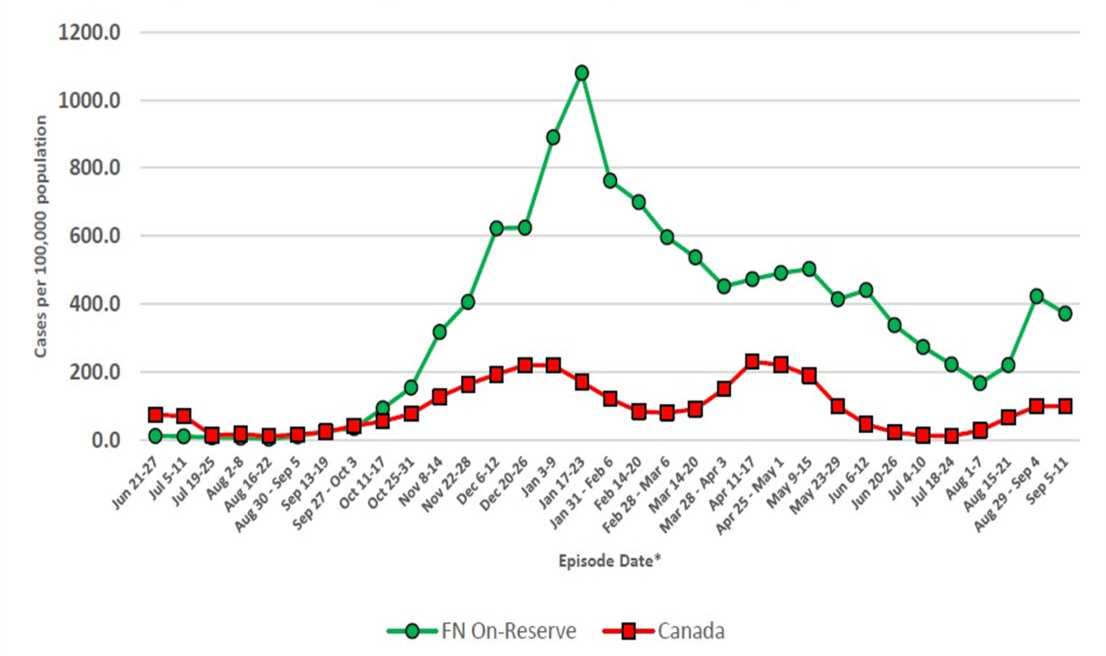
Text alternative for Rate of cases per 100,000 population of active COVID-19 cases by week
| Week | First Nations Communities on-reserve | General Canadian Population |
|---|---|---|
| Jun 21-27 | 13.5 | 75.2 |
| Jun 28 - Jul 4 | 13.1 | 72.8 |
| Jul 5-11 | 11.9 | 71.9 |
| Jul 12-18 | 8.2 | 11.2 |
| Jul 19-25 | 9.5 | 14.7 |
| Jul 26 - Aug 1 | 10.6 | 16.5 |
| Aug 2-8 | 8 | 17.7 |
| Aug 9-15 | 4.6 | 12.3 |
| Aug 16-22 | 5.1 | 12.4 |
| Aug 23-29 | 5.5 | 13.4 |
| Aug 30 - Sep 5 | 11.7 | 16.4 |
| Sep 6-12 | 21.9 | 18.2 |
| Sep 13-19 | 27.4 | 24.8 |
| Sep 20-26 | 34.7 | 31.9 |
| Sep 27 - Oct 3 | 36.9 | 42.6 |
| Oct 4-10 | 61.9 | 50.7 |
| Oct 11-17 | 95.1 | 55.7 |
| Oct 18-24 | 119.9 | 64.3 |
| Oct 25-31 | 156.4 | 77.6 |
| Nov 1-7 | 214.4 | 96.1 |
| Nov 8-14 | 319.7 | 128.5 |
| Nov 15-21 | 390.3 | 143.9 |
| Nov 22-28 | 414.2 | 165.6 |
| Nov 29 - Dec 5 | 544 | 189.9 |
| Dec 6-12 | 640.9 | 194.1 |
| Dec 13-19 | 666.2 | 201.9 |
| Dec 20-26 | 661.1 | 221.7 |
| Dec 27 - Jan 2 | 701.8 | 200.3 |
| Jan 3-9 | 942.5 | 220.7 |
| Jan 10-16 | 1196.5 | 202.4 |
| Jan 17-23 | 1139 | 171.6 |
| Jan 24-30 | 912.2 | 144 |
| Jan 31 - Feb 6 | 819 | 121.8 |
| Feb 7-13 | 751.1 | 98 |
| Feb 14-20 | 761.7 | 85.5 |
| Feb 21-27 | 723.7 | 83.4 |
| Feb 28 - Mar 6 | 660.2 | 80.8 |
| Mar 14-20 | 602.7 | 80.7 |
| Mar 21-27 | 565.5 | 102.1 |
| Mar 28 - Apr 3 | 517.5 | 139.4 |
| Apr 4-10 | 519.7 | 178.2 |
| Apr 11-17 | 538.7 | 220.0 |
| Apr 18-24 | 567.5 | 218.6 |
| Apr 25 - May 1 | 573.9 | 210.9 |
| May 2-8 | 597.1 | 203.8 |
| May 9-15 | 602.0 | 179.4 |
| May 16-22 | 565.9 | 137.1 |
| May 23-29 | 525.5 | 89.2 |
| May 30 - Jun 5 | 541.4 | 56.3 |
| Jun 6-12 | 561.8 | 35.6 |
| Jun 13-19 | 535.9 | 21.5 |
| Jun 20-26 | 456.4 | 12.8 |
| Jun 27 - Jul 3 | 423.9 | 5.7 |
| Jul 4-10 | 392.3 | 3.5 |
| Jul 11-17 | 344.9 | 1.7 |
| Jul 18-24 | 341.2 | 1.8 |
| Jul 25-31 | 308.9 | 7.5 |
| Aug 1-7 | 287.2 | 17.8 |
| Aug 8-14 | 311.7 | 36.5 |
| Aug 15-21 | 353.8 | 55.7 |
| Aug 22-28 | 483.0 | 70.9 |
| Aug 29 - Sep 4 | 582.8 | 88.3 |
| Sep 5-11 | 627.7 | 102.0 |
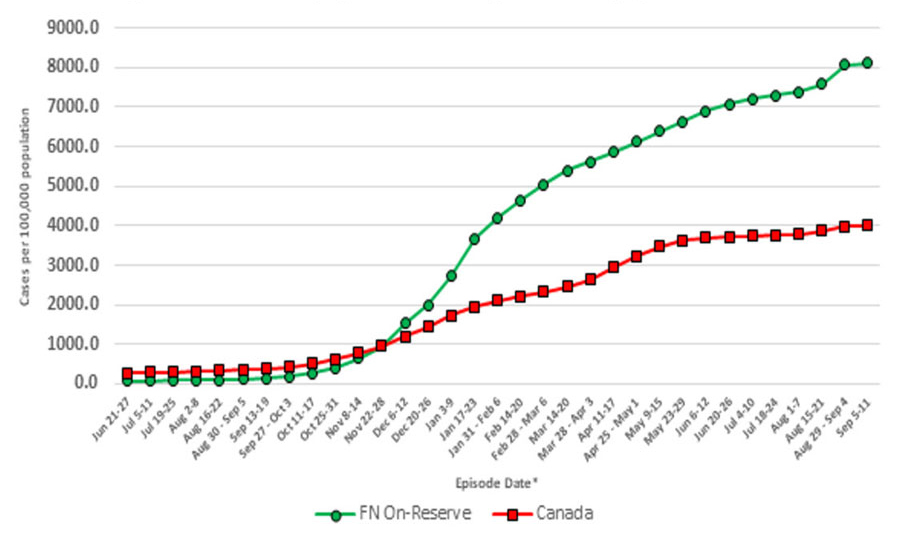
Text alternative for Rate of cumulative cases per 100,000 population of active COVID-19 cases by week
| Week | First Nations Communities on-reserve | General Canadian Population |
|---|---|---|
| Jun 21-27 | 69.9 | 271.1 |
| Jun 28 - Jul 4 | 75.7 | 277.1 |
| Jul 5-11 | 79.4 | 282.4 |
| Jul 12-18 | 81.6 | 289.4 |
| Jul 19-25 | 86.5 | 298.8 |
| Jul 26 - Aug 1 | 90.5 | 306.8 |
| Aug 2-8 | 93.8 | 313.7 |
| Aug 9-15 | 94 | 320.7 |
| Aug 16-22 | 96.7 | 327.9 |
| Aug 23-29 | 99.1 | 335.9 |
| Aug 30 - Sep 5 | 106.9 | 346 |
| Sep 6-12 | 120.4 | 358.2 |
| Sep 13-19 | 136.3 | 375.7 |
| Sep 20-26 | 154.2 | 399.1 |
| Sep 27 - Oct 3 | 173.9 | 432.7 |
| Oct 4-10 | 212.4 | 474.1 |
| Oct 11-17 | 259.7 | 516.6 |
| Oct 18-24 | 315.5 | 563 |
| Oct 25-31 | 397.4 | 619.5 |
| Nov 1-7 | 504.4 | 684.3 |
| Nov 8-14 | 647.8 | 769.8 |
| Nov 15-21 | 795.2 | 858.9 |
| Nov 22-28 | 960 | 961.9 |
| Nov 29 - Dec 5 | 1237 | 1077.6 |
| Dec 6-12 | 1523.3 | 1198.6 |
| Dec 13-19 | 1788.3 | 1321.5 |
| Dec 20-26 | 1992.7 | 1440.2 |
| Dec 27 - Jan 2 | 2201.2 | 1529.8 |
| Jan 3-9 | 2724.2 | 1718.2 |
| Jan 10-16 | 3277.5 | 1849.1 |
| Jan 17-23 | 3697.4 | 1955.1 |
| Jan 24-30 | 3982.2 | 2040.4 |
| Jan 31 - Feb 6 | 4201.6 | 2108.9 |
| Feb 7-13 | 4414.5 | 2167.6 |
| Feb 14-20 | 4647.9 | 2220.2 |
| Feb 21-27 | 4866.3 | 2275.6 |
| Feb 28 - Mar 6 | 5054.3 | 2327.6 |
| Mar 14-20 | 2449.8 | 5397.5 |
| Mar 21-27 | 2531.2 | 5532.6 |
| Mar 28 - Apr 3 | 2635.5 | 5624.0 |
| Apr 4-10 | 2772.8 | 5751.5 |
| Apr 11-17 | 2933.6 | 5873.4 |
| Apr 18-24 | 3086.1 | 6008.3 |
| Apr 25 - May 1 | 3230.8 | 6125.4 |
| May 2-8 | 3369.4 | 6255.7 |
| May 9-15 | 3484.0 | 6391.3 |
| May 16-22 | 3568.2 | 6495.5 |
| May 23-29 | 3623.1 | 6636.7 |
| May 30 - Jun 5 | 3661.0 | 6766.1 |
| Jun 6-12 | 3686.6 | 6913.2 |
| Jun 13-19 | 3705.3 | 7019.8 |
| Jun 20-26 | 3717.8 | 7092.2 |
| Jun 27 - Jul 3 | 3727.7 | 7160.1 |
| Jul 4-10 | 3737.2 | 7212.1 |
| Jul 11-17 | 3744.2 | 7254.8 |
| Jul 18-24 | 3752.7 | 7309.0 |
| Jul 25-31 | 3765.9 | 7346.6 |
| Aug 1-7 | 3786.5 | 7398.6 |
| Aug 8-14 | 3820.8 | 7473.9 |
| Aug 15-21 | 3865.0 | 7599.7 |
| Aug 22-28 | 3921.4 | 7845.1 |
| Aug 29 - Sep 4 | 3986.9 | 8134.9 |
| Sep 5-11 | 4059.8 | 8457.5 |
These charts show that while hospitalization rates remain lower in First Nation communities, the cumulative COVID-19 rate and the rate of deaths in First Nation communities is now higher than the rate in the general population.
- Hospitalizations remain lower in First Nation communities, but the cumulative COVID-19 rate and the rate of deaths in First Nation communities is now higher than the rate in the general population.
| COVID-19 Cases Cumulative Rate per 100,000 | COVID-19 Cases Active Cases per 100,000 | Hospitalizations* | Deaths Rate per 100,000 | |
|---|---|---|---|---|
| Canada | 4,014.3 | 97.5 | 7.5% | 71.2 |
| First Nations | 8,096.2 | 349.6 | 4.7% | 88.3 |
| *Includes only cases with available hospital data Data as of September 7, 2021 |
||||
The impact of COVID-19 has varied by region
- The number of reported COVID-19 cases has been highest in Alberta, Saskatchewan and Manitoba.
- This map provides an overview of the number of reported cases by distinction and jurisdiction:
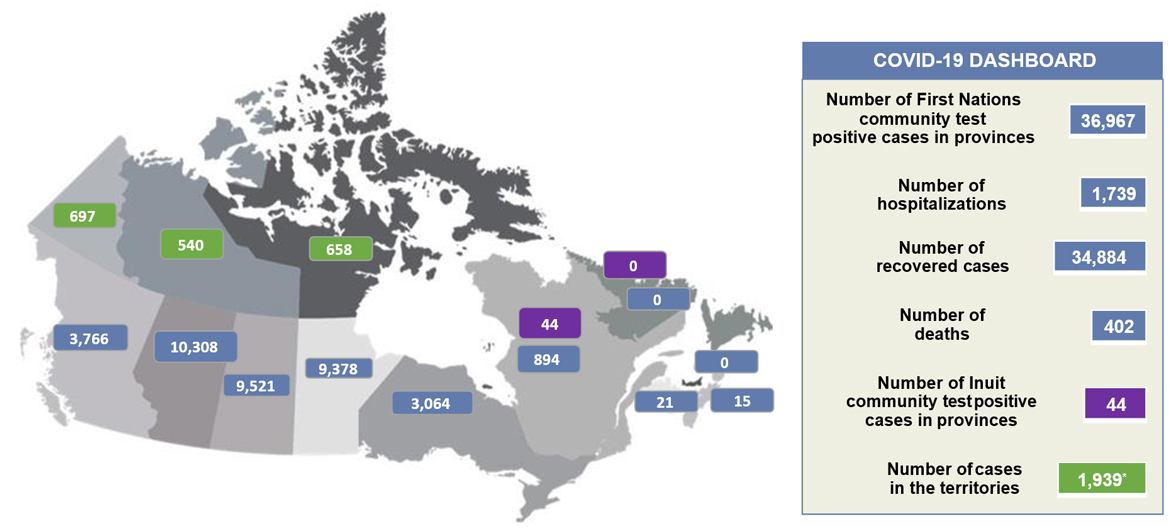
Text alternative for Number of reported cases by distinction and jurisdiction
- Number of First Nations on Reserve community test positive cases in provinces: 36,977
- British Columbia: 3,766
- Alberta: 10,308
- Saskatchewan: 9,521
- Manitoba: 9,378
- Ontario: 3,064
- Quebec: 894
- New Brunswick: 21
- Nova Scotia: 15
- Prince Edward Island: 0
- Newfoundland and Labrador: 0
- Number of hospitalizations: 1,738
- Number of recovered cases: 34,884
- Number of deaths: 402
- Number of Inuit community test positive cases in provinces: 44
- Quebec: 44
- Newfoundland and Labrador: 0
- Number of cases in the territories: 1,939*
- Yukon: 697
- Northwest Territories: 540
- Nunavut: 658
*In the territories, the total number of cases is not broken down specifically by Indigenous identity.
Data as of September 8, 2021
* In the territories, the total number of cases is not broken down specifically by Indigenous identity.
Federal Response: Rapid mobilization of support for public health measures and community-based solutions
- Many components were already in place to support an effective response to public health risks:
- over 95% of First Nation communities already had pandemic and emergency plans in place;
- ISC regional offices had strong relationships with Indigenous communities across the country, with mechanisms in place to support open and frequent communication and collaboration;
- pre-existing stockpile of personal protective equipment, hand sanitizer and testing swabs for First Nations on-reserve; and
- a national network of public health experts.
- ISC quickly mobilized supports to ensure Indigenous communities had the necessary tools and resources to implement public health measures and community-based solutions to respond to COVID-19.
- The COVID-19 Public Health Fund was established to provide Indigenous communities with rapid and flexible funding to implement public health measures.
- In parallel, ISC worked closely with communities to provide guidance on COVID-19 and support access to:
- point-of-care testing and training;
- personal protective equipment and cleaning supplies;
- surge support for health human resources;
- temporary structures for isolation; and
- additional funding for mental wellness and supportive care facilities.
- ISC also supported ongoing surveillance and reporting on cases as the pandemic evolved.
Key to the Federal Response: Communications, partnerships, and support for community-based solutions
Partnerships
ISC worked closely with Indigenous leaders and organizations, provinces and territories, and other government departments to respond to the pandemic:
- supported Indigenous leadership, Indigenous health providers and trusted sources to lead messaging at the national, regional and local level to increase confidence;
- partnered with local health authorities increased supplies and personal protective equipment for urban vaccine clinics; and
- partnered with the Canadian Armed Forces helped provide critical operational support to remote and isolated communities across Canada (including Ontario and Manitoba).
Community support
The Indigenous Community Support Fund (ICSF) was established to provide First Nations, Inuit, and Métis and urban/off-reserve Indigenous leadership and organizations with flexible funding to implement community-based solutions to prevent, prepare and respond to the spread of COVID-19. This fund, which was replenished throughout the pandemic, can be used for a wide range of measures, including:
- support for Elders and vulnerable community members;
- measures to address food insecurity;
- educational and other support for children;
- emergency response services; and
- preparedness measures to prevent the spread of COVID-19, including perimeter security.
Communications
Emergency regulations put in place to allow First Nation Chief and Council to postpone or cancel elections.
ISC worked closely with Indigenous partners to ensure communications products were relevant, culturally appropriate and strategically disseminated. ISC also supported the Public Health Agency of Canada to translate information into Indigenous languages.
- providing information in Indigenous languages increased the reach of the messaging and confidence in the information;
- word of mouth as well as social media and radio were effective in reaching Indigenous populations; and
- online live sessions/townhalls with a Q&A format allowed for individuals to pose questions.
Key to the Federal Response: Additional supports to address the broader impacts of the pandemic
- In addition to the public health risks, the pandemic presented a range of social and economic challenges and risks in Indigenous communities. Initiatives were undertaken across ISC, in partnership with Indigenous communities and leaders, to mitigate these risks.
Social
Additional supports introduced to mitigate the social risks and impacts of the pandemic included:
- funding for a network of emergency shelter and transitional housing to address the elevated risk of family violence;
- funding to improve safety in supportive care facilities and programs that support seniors and persons with disabilities;
- increased income and employment supports to address job loss and greater needs of income assistance clients; and
- introduced more flexibilities into First Nations Child and Family Services: additional support for children aging out of care, expanding eligible expenses.
Economic
Support was provided to Indigenous businesses and communities to help manage revenue loss during COVID-19. This included:
- the Indigenous Business Initiative, which included interest-free loans and non-repayable contributions to Indigenous businesses;
- the Indigenous Community Business Fund, which provided financial relief to First Nations, Inuit and Métis Nation community-owned and micro-businesses that did not qualify for other COVID-19 relief measures, to offset their operating losses or adapt their operations;
- the Own-Source Revenue in Indigenous Communities Initiative is providing a one-time economic response funding of up to $1M per community to partially offset declines in their own-source revenues; and
- the Aboriginal Entrepreneurship Program provides target support to the Indigenous tourism industry.
Community
Recognizing the need for communities to focus on the pandemic response, a number of measures were introduced to reduce the administrative burden on Indigenous communities, facilitate disbursement of federal funds, and maximize cash flow. Examples include:
- a shift to electronic signatures on funding agreements;
- delaying reporting requirements; and
- greater flexibility with eligible expenditures (i.e., maximized flexibilities in program terms and conditions).
Key to the Federal Response: Support for a Safe Restart
- A number of measures were also introduced to support a safe restart and resumption of regular services and activities.
Education
Investments were made to support a safe return to school for children in Indigenous communities
- funding for elementary and secondary education on-reserve, including personal protective equipment for students and staff, laptops to support online learning, and more teachers and other critical staff; and
- support for Indigenous post-secondary education students and institutions.
Infrastructure
Existing infrastructure was adapted and measures introduced to allow work on new infrastructure projects to resume, including:
- funding to support building adaptations on-reserve, including improvements to ventilation, plexiglass, and hand-washing stations; and
- additional funding for infrastructure projects to address the increased costs associated with COVID-19 (delays, increased material costs, health and safety measures).
Services
In light of the ongoing threat posed by the pandemic, greater flexibility was introduced to the way ISC services were delivered where possible. For example:
- Individual Affairs Services – service efficiencies and added flexibilities for treaty payments and for individuals applying for registration, status cards and estate-related services;
- providing First Nations the option of Self-Administering Treaty Payments in lieu of treaty payment events; and
- introducing access to virtual mental health counselling.
Vaccine rollout: Efforts to date
- Vaccines have been critical to moderating the number of COVID-19 cases in Indigenous communities and allowing a shift away from crisis response towards safe restart.
- While provinces and territories lead the vaccine rollout, federal engagement and partnership has been important to ensuring that Indigenous partners were included in vaccine planning and that Indigenous Peoples have access to vaccines in a timely and culturally-safe way.
- Prioritization: ISC advocated for the prioritization of Indigenous populations for the vaccine with provinces and territories, as per recommendations from the National Advisory Committee on Immunization:
- bilateral engagement with National Indigenous Organizations;
- multilateral engagement with provinces and territories through a newly established forum of Federal, Provincial and Territorial Deputy Ministers of Indigenous Affairs; and
- trilateral engagement with provinces and territories, national and regional Indigenous organizations through a newly establish Federal, Provincial, Territorial and Indigenous Vaccine Planning Working Group.
- Vaccine Hesitancy: Extensive collaboration with Indigenous leadership to promote vaccine confidence, including:
- Indigenous Languages: translation of public health guidance into Indigenous languages;
- Community Leadership: leveraging community leadership (e.g., Chiefs and Elders) to promote vaccine uptake; and
- Cultural Safety: partnerships with the National Association of Friendship Centres, Indigenous Primary Health Care Council, and many more to support the administration of vaccines to urban and off-reserve Indigenous populations.
- Vaccine Administration: Extensive coordination with provinces and territories and communities on vaccine rollout in Indigenous communities
- Data: monitoring conditions on the ground (e.g., upticks in community cases, supplies and risks, and outbreaks);
- Surge Support: partnership with the Canadian Armed Forces to deploy Canadian Rangers to northern and remote communities in Manitoba to support logistics and the administration of vaccines to residents; and
- Community-based Solutions: support provided via ICSF to various communities and organizations, including First 10 Nations, to administer vaccines and provide vaccine-related supports to urban/off-reserve Indigenous population (e.g., transportation to appointments, mobile vaccine clinics, cultural supports at clinics, and more).
Vaccine rollout in Indigenous communities continues to show progress
- There are 687 communities with access to vaccine clinics and to date, 755,639 doses have been administered (89% of population aged 12 and over), with 332,768 of these being second doses (about 70% of population aged 12 and older).
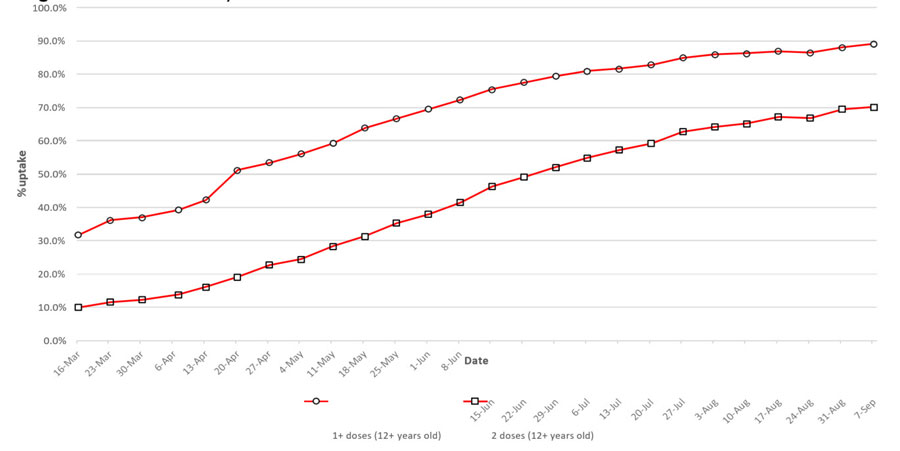
Text alternative for Vaccine Coverage for First Nations, Inuit, and Territories
| Date | At Least 1 Dose (12+) | Fully Immunized (12+) |
|---|---|---|
| 16-Mar | 31.9% | 10.1% |
| 23-Mar | 36.3% | 11.7% |
| 30-Mar | 37.2% | 12.3% |
| 7-Apr | 39.4% | 13.9% |
| 13-Apr | 42.4% | 16.2% |
| 20-Apr | 51.4% | 19.2% |
| 27-Apr | 53.6% | 22.9% |
| 4-May | 56.3% | 24.6% |
| 11-May | 59.5% | 28.5% |
| 18-May | 64.1% | 31.5% |
| 25-May | 67.0% | 35.5% |
| 1-Jun | 69.8% | 38.1% |
| 8-Jun | 72.6% | 41.7% |
| 15-Jun | 75.8% | 46.5% |
| 22-Jun | 77.8% | 49.4% |
| 29-Jun | 79.8% | 52.3% |
| 6-Jul | 81.3% | 55.1% |
| 13-Jul | 82.0% | 57.5% |
| 20-Jul | 83.1% | 59.5% |
| 27-Jul | 85.3% | 63.0% |
| 3-Aug | 86.3% | 64.5% |
| 10-Aug | 86.7% | 65.5% |
| 17-Aug | 87.2% | 67.5% |
| 24-Aug | 86.8% | 67.2% |
| 31-Aug | 88.4% | 69.9% |
| 7-Sep | 89.5% | 70.4% |
- This graph displays one-dose and two-dose vaccination rates in the territories, as of September 7, 2021.
*In the territories, counts and percentages include vaccines administered in Indigenous and non-Indigenous communities. Data as of September 7, 2021.
Key Successes
Indigenous Leadership
- Indigenous communities demonstrated strong leadership and acted fast to implement public health advice and the closure of their borders to non-essential traffic. Strong partnerships with Indigenous communities and leadership supported a quicker and more efficient response.
- particularly in British Columbia, where First Nations directly deliver health services and where collaboration is hard-wired in the provincial system, the response was much more seamless; and
- the Indigenous Community Support Fund supported community-based solutions to prevent, prepare and respond to the pandemic (e.g. perimeter security, food security, etc.)
Flexibility
- Increased funding and flexibility strengthened the capacity of communities and Indigenous leadership to respond to the health, social and economic impacts of the pandemic.
Engagement
- Frequent engagement with all partners involved, including provinces and territories and national and regional Indigenous organizations supported collaboration and 'just-in-time' coordination, including rapid response to outbreaks and improved vaccine distribution and administration. Formal mechanisms established included:
- the Federal, Provincial, Territorial and Indigenous Vaccine Planning Working Group; and
- the Forum of Federal-Provincial/Territorial Deputy Ministers of Indigenous Affairs.
Urban/Off Reserve Support
- Increased focus and support for urban and off-reserve Indigenous populations (e.g., ensuring culturally safe vaccine distribution through the National Association of Friendship Centres and through Métis governments, and other urban/off-reserve Indigenous organizations who provided critical COVID-19 supports)
Prioritization
- Early outreach to provinces and territories helped ensure Indigenous populations were prioritized for the vaccine.
Vaccine Confidence
- Efforts to improve vaccine confidence (i.e. targeted communications, translated materials, use of Elders and community leadership).
Lessons learned
Health Human Resources
- The pandemic highlighted gaps and or challenges in health human resources, such as high reliance on agency nurses, chronic supply shortages leading to difficulties in identifying and deploying surge capacity, lack of transportation and longstanding challenges with nursing recruitment and retention. Going forward, a renewed primary care and public health - health human resources strategy is needed.
Data
- Public health data within Indigenous communities was lacking, making it difficult to track the impact of the pandemic on Indigenous Peoples and progress with vaccines. While data exists for First Nations on-reserve, data for Inuit is extrapolated from territorial data, which includes non-Inuit populations, and no data currently exists for Métis and urban, off-reserve populations at a national level.
Urban/Off Reserve
- The high demand for support from urban and off-reserve Indigenous organizations through the ICSF and other programs demonstrated the important role these organizations play in supporting First Nations, Inuit and Métis living in urban locations and the need to ensure ISC programs adequately support them.
Federal-Provincial / Territorial Relations
- The coordination of a common approach to vaccine rollout across 13 health care systems was a challenge, particularly as it related to the prioritization of at-risk populations, such as Indigenous Peoples. Early engagement through multilateral fora, such as the forum of Federal, Provincial and Territorial Deputy Ministers of Indigenous Affairs helped to promote consistency in approach.
Streamlining Services
- A holistic approach to funding and programming. Potential wider use of the single window approach, such as the ICSF's no wrong door approach, which reduced confusion and administrative burden at the community level.
The fight is not over: Priorities moving forward
- Fourth and subsequent waves: Need to continue to be responsive, particularly with respect to health human resources, and continued risks associated with variants of concern
- Shortages: lack of nurses, paramedics, contact tracers, lab technicians, epidemiologists, allied health professionals in many regions; and
- Fatigue: risk of burn-out could compromise quality care and the government's agenda for improving health outcomes – need to consider strategies for workforce retention.
- Pediatric Vaccinations: Given that Indigenous populations are relatively young and growing, it will be difficult to achieve herd immunity without pediatric vaccinations
- Pending regulatory approval from Health Canada, pediatric vaccinations are not likely to begin until early January 2022, which will likely see ISC involved in promoting the prioritization and administration of vaccines for Indigenous children aged five years to 12.
- Proof of Vaccination Credential: Working with the Public Health Agency of Canada and Immigration, Refugees and Citizenship Canada on the implementation of proof of vaccination credentials
- ISC is supporting engagement with national and regional Indigenous partners.
- Vaccine Confidence: Still room for improvement with respect to bridging deep-seated skepticism in government communications with Indigenous communities
- ISC is continuing to promote vaccine confidence by working with community leadership to increase the credibility of public health guidance and messaging.
- Mandatory vaccinations for federally-regulated workplace and sectors: Working with Transport Canada to support engagement with Indigenous partners. Consideration is needed for remote and isolated Indigenous communities who rely on this transportation to access medical care not available in their communities.
- ISC is also supporting Employment and Social Development Canada on engagement and analysis of implications for the federally-regulated workplace, including Band Council members.
- Implementation of the "Fourth Wave Action Plan" and associated six point strategy:
- develop strategic communication on fourth wave risk and vaccination and amplify Indigenous-led COVID-19 initiatives;
- focused approach to encourage/support all eligible Indigenous Peoples to be vaccinated, including through federal collaboration with provinces, territories and Indigenous partners (where numbers are low);
- minimize spread of infection and variants of concern;
- support community testing, screening and contact tracing;
- monitor epidemiological landscape to inform outbreak management and support communities and provinces and territories with surge resources where needed; and
- develop guidance to optimize implementation and adherence to public health measures.
- Continued supports through the Indigenous Community Support Fund to support the local response to emergencies and outbreaks, with a greater focus on needs-based funding and developing a post-pandemic strategy.
- Exploring options to leverage investments and lessons learned during the COVID-19 pandemic (e.g., perimeter security, food security, capital investments).
ANNEX A: COVID-19 waves by the numbers
- During the first wave, First Nation communities saw a weekly average of 99 total active cases. This increased to a peak of 5,131 active cases during the second wave.
- increases in the number of new and active cases in First Nation communities were about 42 and 48 times the maximum number of cases during the first wave. Cases were highest in Alberta, Saskatchewan and Manitoba.
- As of September 8, 2021, there were more than 5,982 cumulative cases of variants of concern in First Nation communities in British Columbia, Alberta, Saskatchewan, Manitoba, Ontario, and Quebec.
- While the rate of hospitalizations is lower in First Nation communities, the rate of cumulative cases, active cases, and deaths in First Nation communities (per 100,000) is now higher than the rate in the general population.
| COVID-19 Cases Cumulative Cases per 100,000 |
COVID-19 Cases Active Cases per 100,000 |
Hospitalizations* | Deaths Rate per 100,000 |
|
|---|---|---|---|---|
| Canada | 4,014.3 | 97.5 | 7.5% | 71.2 |
| First Nations | 8,096.2 | 349.6 | 4.7% | 88.3 |
| *Includes only cases with available hospital data Data as of September 7, 2021 |
||||
ANNEX B: Vaccine Rollout to Indigenous Communities
1. Procurement
The Government of Canada procures vaccine doses from pharmaceutical companies
2. Distribution
Provinces and territories are responsible for the delivery of vaccines to either depots or directly to Indigenous communities within their jurisdiction
3. Administration
First Nations – administration delivered primarily by First Nations-run public health services or through ISC-managed programs and staff. In British Columbia, the First Nations Health Authority has responsibility for health service design and delivery.
Inuit – Inuit living in Inuit Nunangat receive immunization services from the province or territory in which they reside.
Métis and urban Indigenous populations – Métis populations receive their immunization through providers for the general population (e.g., pharmacies, family doctors) as well as from Indigenous community services, such as friendship centres.
ANNEX C: COVID-19 Response Measures, by Sector
First Nations and Inuit Health
- COVID-19 Public Health Fund
- Point of Care testing
- Personal Protective Equipment
- Supporting vaccine rollout
- Surge human health resources
- Surge health infrastructure support
- Federal/provincial/territorial/Indigenous engagement and co-planning
- Public health and primary care advice, guidance, and action plans
- Case surveillance and vaccine uptake tracking
- Community Capacity Building Support
- Emergency Operations Centre
- Environmental Public Health Support
- Mental Wellness Support
Lands and Economic Development
- Indigenous Business Initiative
- Indigenous Community Business Fund
- Own Source Revenue Indigenous Communities Initiative
- Indigenous Personal Protective Equipment
- Procurement Task Force
- Indigenous Tourism support
Regional Operations
- Indigenous Community Support Fund
- COVID-19 emergency management
- Infrastructure project cost increases
- Infrastructure adaptations for schools on-reserve
- Adjustments to Individual Affairs services
Education and Social Development
- Supportive Care Initiative
- Family Violence Prevention Program
- First Nations and Inuit Youth Employment Strategy
- Income Assistance Program
- Safe Return to School
- Support for Indigenous post-secondary students and institutions
Child and Family Services
- Flexibilities integrated into First Nations Child and Family Services for children aging out of care and eligible expenses
Communications
- Culturally appropriate messaging
- Tailored community considerations
- Regional communications
ANNEX C: COVID-19 Response Measures
First Nations and Inuit Health Branch
Support the primary care and public health response to the pandemic in Indigenous communities
- COVID-19 Public Health Fund: Flexible funding provided to communities on a needs basis to support public health measures.
- Point of Care testing: Support real-time COVID-19 testing and training in Indigenous communities, critical for effective contact tracing and case management.
- Personal Protective Equipment: Distribution of personal protective equipment to support the delivery of health and other essential services in Indigenous communities and Indigenous organizations as well as people in communities who are sick with COVID-19 or taking care of a sick family member or require to travel outside of community for care.
- Supporting vaccine rollout: Support planning for vaccine rollout with partners through the operation of multiple Federal, Provincial, Territorial and Indigenous working groups; provide vaccine administration supplies and mini clinic kits; promote vaccine confidence.
- Surge human health resources: Deployment of additional health personnel, such as immunizers, and dedicated air services for healthcare workers in First Nation communities, development of a health human resources roster utilizing national campaign.
- Surge health infrastructure: Delivery of mobile structures and adapting existing community spaces for health infrastructure in First Nation communities.
- Federal/provincial/territorial/Indigenous engagement and co-planning: Advocating for the prioritization of Indigenous Peoples and Indigenous needs in health and safety planning, vaccine prioritization (including for Métis and Indigenous Peoples in urban areas), and consideration for border communities in the implementation of proof 20 of vaccine credentials.
- Public health and primary care advice, guidance, and action plans: Develop, maintain and disseminate guidance and action plans specific to the context in First Nation communities through ISC networks, Regional Medical Officers and Nurses, and Indigenous partners.
- Case surveillance and vaccine uptake tracking: COVID-19 case reporting, including hospitalizations and deaths, and vaccine uptake and severe adverse event tracking for First Nation and Inuit communities in the provinces and all territorial communities.
- Community Capacity Building Support: Skills building and support for community health workers and public health assistants.
- Emergency Operations Centre: A central coordinating function for the First Nations and Inuit Health Branch.
- Environmental Public Health Support: Providing leadership in emergency response and mitigating the public health impacts of the pandemic (e.g., assessment of public facilities, guidance on applying public health measures and supporting vaccination clinics and rapid testing).
- Mental Wellness Support: Funding for Indigenous communities and service delivery organizations (including Métis) for the adaptation and expansion of mental wellness services to improve access and, to address growing demand in the context of the COVID-19 pandemic.
Regional Operations
Non-health related emergency management services, infrastructure delivery, and Individual Affairs services.
- Indigenous Community Support Fund: Funding to First Nations, Inuit, Métis, Urban/off-reserve populations for community based solutions to prevent, prepare, and respond to COVID-19:
- announced March 2020, ICSF had 3 tranches of allocations in 2020-2021. Budget 2021 provided another full year of funding for until March 31, 2022;
- funded supports include: perimeter security, food security, educational and cultural supports; mental health assistance; and emergency response services;
- funded through direct allocations to Indigenous communities and organizations, and a "single-window approach," for needs based-requests; and
- analysis is underway to assess potential future needs.
Non-health related emergency management services, infrastructure delivery, and Individual Affairs services.
- Infrastructure project cost increases: Funding expenses related to infrastructure projects on-reserve already under construction that experienced cost increases as result of COVID-19 (delays, increased material costs, increased health and safety measures, restricted access to communities, etc.).
- Delays in infrastructure delivery: Delays to the construction and commissioning have delayed access for community members to services (health services, connectivity services, cultural and recreational services, educational services, etc.).
- Infrastructure adaptations for schools on-reserve: Funding for school retrofitting to prepare for return to school, such as Plexiglas and disinfection and handwashing stations.
- Adjustments to Individual Affairs Services: Indian registration and estate management services were modified to support remote work, resulting in service efficiencies and added flexibilities for individuals applying for registration and status cards and estate related services. In lieu of traditional in-person treaty payment events, three options were offered to First Nations, including a First Nations Self-Administered Treaty Payment process.
Education and Social Development
Supplemental funding for social and educational programs to support Indigenous communities prevent, prepare, and respond to COVID-19.
- Supportive Care Initiative: Funding for First Nations and Inuit long-term care facilities and programs that support seniors and persons with disabilities.
- Family Violence Prevention Program: Funding for network of emergency shelter and transitional housing to Indigenous, women, children, families, and Two Spirit, lesbian, gay, bisexual, transgender, queer, questioning, intersex and/or asexual people.
- Safe Return to School: Funding for elementary and secondary education on-reserve is used to address various COVID-19 pressures, in support of a safe restart in First Nation communities, including personal protective equipment for students and staff, laptops to support online learning, and more teachers and other critical staff.
- First Nations and Inuit Youth Employment Strategy: Funding for one-year pilot partnered between First Nations and Inuit Youth Employment Strategy and Income Assistance programs to restore pre-COVID-19 employment levels and provide 2000 youth who receive Income Assistance with additional supports to meet the goals of reducing poverty and relying on income assistance on a long-term basis.
- Income Assistance Program: Funding to address increased demand due to COVID-19 by providing additional supports to individuals and families and capacity to Income Assistance administrators.
- Support for Indigenous post-secondary students and institutions: Funding to help offset the lost income that many Indigenous students rely on to pay for tuition, books, housing, and other living expenses; funding for Indigenous post-secondary institutions and community-based programming, 24 which have signaled that they require additional funding to meet current needs.
Lands and Economic Development
Support for Indigenous businesses and communities to support with revenue loss during COVID-19.
- Indigenous Business Initiative (previously known as COVID-ISI): Provides interest-free loans and non-repayable contributions to Indigenous businesses and lenders impacted by COVID-19; mirrors the Canada Emergency Business Account.
- Indigenous Community Business Fund: Provides financial relief to First Nation, Inuit and Metis Nation community-owned and micro-businesses that do not qualify for other federal COVID-19 relief measures or need additional support to offset operating losses and adapt their operations.
- Own Source Revenue Indigenous Communities Initiative: Provides funding to Indigenous communities to partially offset the decline in their own-source and taxation revenues used to provide core programs and important community services.
- Indigenous Personal Protective Equipment Procurement Task Force: Provided support for the creation and operation of an Indigenous task force to support the procurement of Personal Protective Equipment from Indigenous businesses.
- Indigenous Tourism Stimulus Fund: Provided funding in 2020-2021 to the Indigenous Tourism Association of Canada, to help the Indigenous tourism industry rebuild and 25 recover from the impacts of COVID-19.
Child and Family Services
Flexibilities integrated into First Nations Child and Family Services for children aging out of care and eligible expenses.
- Additional eligible expenses: Until the end of the pandemic, First Nations can now use funding for temporary lodging for children or caregivers to prevent the spread of COVID-19; supplies for children (e.g., diapers, wipes, baby formula, etc); childcare services; emergency food for families; personal protective equipment; and equipment, supplies or services needed to support child and family services workers; etc.
- Transition services for children aging out of care: First Nations children aging out of care can now receive services to help ensure their needs are supported as they transition out of the child welfare system, for up to a maximum of two years. While initially a temporary measure in response to COVID-19, based on feedback from partners, this is now a permanent service.
Communications
Co-developed, Indigenous-led, distinctions-based communications.
- Culturally appropriate messaging: Co-developing and supporting culturally safe messaging to create products and organize events to further address key concerns and increase awareness of the public health measures as well as benefits of COVID-19 vaccines and to dispel disinformation and vaccination hesitancy.
- Tailored community communications: Regularly updating COVID-19 vaccines and Indigenous Peoples webpages, toolkits, public service announcements (in 20 Indigenous languages), social media posts, pamphlets, radio scripts, frequently asked questions, town halls, videos, advertising campaigns.
- Regional communications: Partnering with First Nation, Inuit and Métis organizations and communities to create regional, community-specific micro-strategies designed to address community-specific opportunities and barriers; supporting community leadership in developing strategies as a means to advance self-determination.
8. Overview of First Nations, Inuit and Métis Cultural Protocols
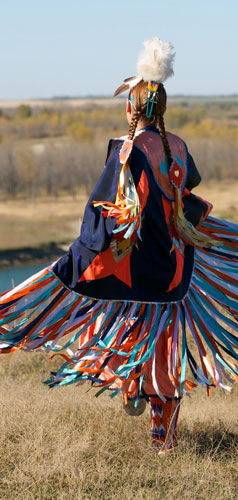
Context
- As part of its commitment to reconciliation the Government of Canada has engaged with various Elders and Knowledge Keepers to increase the understanding and acknowledgement of cultural protocols that are vital to establishing meaningful and lasting relationships with Indigenous peoples and communities.
- The diversity and distinctions among First Nations, Métis and Inuit, and their worldviews in Canada is immense and very complex; it is not possible to apply one national protocol given the specificity and context.
Guiding Principles
- To ensure Government officials work effectively to uphold and demonstrate the commitment to relationship rebuilding and ongoing reconciliation, principles for engagement with respect to cultural protocols have been established to promote and sustain positive strong relations with First Nations, Métis and Inuit communities:
- Recognition of Indigenous Peoples, diversities and distinctions between cultures is a benefit for all Canadians;
- All relations with Indigenous Peoples shall be based on humility and respect;
- First Nations, Métis and Inuit communities have the right to determine who their community Elders, Traditional Knowledge Keepers and other cultural representatives are;
- Culturally engaging with Indigenous people is an opportunity to demonstrate reconciliation through cooperation and collaboration;
- The approach in how officials and public servants engage with and care for community Elders, Knowledge Keepers and/or other cultural representatives is critical and will reflect in First Nations, Métis and Inuit communities.
Considerations
- Government officials who wish to engage First Nations, Métis and Inuit Elders, Knowledge Keepers and other cultural representatives are encouraged to seek advice from Indigenous partners, on:
- who are the right key people to engage,
- how to appropriately and respectively interact with them, and (3) ask key questions on the traditional protocols and customary practices of the nation.
Culture and Traditions
First Nations
- Elders
- An elder from the community of the region in which the event is being held should be invited to present a prayer or a blessing to open and possibly to close the event.
- Smudging is usually only reserved for very specific events, such as negotiations and unique discussions. In the case of a prayer/blessing, it is recommended to provide a specific length of time for the prayer/blessing.
- Ceremonies
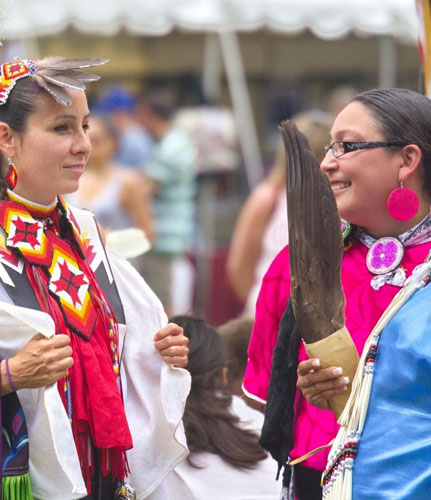
- In ceremonies where First Nations are central participants, it can be expected that representatives will request that sacred objects be included, such as drums, feathers and eagle staffs. Provisions should be made to accommodate these sacred objects as much as possible and displayed in a prominent manner during the ceremony.
- Note that if eagle staffs are to be included, it is advisable to request that the First Nation provide a stand for the staff.
- Feasts
- Feasts can involve sharing of food, natural resources, one's labour, and hospitality.
- Refusal may result in loss of face for one who offers, so if invited to a family's home or to a community feast, politely accepting what is offered is best.
- Gift giving was traditionally a matter of sharing resources, but a thoughtful token of respect is appreciated (value depends on the means of the recipient).
- Smudging
- A 'smudge' is smoke used for ritual cleansing. Smudging is a ceremony traditionally practiced by some Aboriginal cultures (not all) to purify or cleanse negative energy, feelings or thoughts from a place or a person. Sacred medicines such as cedar, sage, sweetgrass or tobacco are burned usually in an abalone shell.
- The shell represents water, the first of four elements of life; the medicines represent gifts from mother earth and the burning represents fire, the next two elements.
- The person puts their hands in the smoke and carries it to their body, especially to areas that need spiritual healing (mind, heart, body). The smoke represents air, the final element.
Inuit
- Elders

- Elders play a strong role in the family and the community and are always acknowledged with respect.
- Elders are regarded as culture-bearers and this plays a significant role in cultural preservation. Designation of an Elder status is not a measure of chronological age, but as a function of the respect accorded to individuals who exemplify the values and lifestyle of the culture.
- When approaching an Inuit Elder for advice, it is customary to present the Elder with a type of offering such as jam or another small gift of food. In First Nations and Métis communities, tobacco is the appreciated gift. Although tobacco does not play a large role in Inuit culture, it can still be offered as a sign of respect.
- Sharing of food and hospitality:
- Refusal to do so may result in loss of face for the one who offers, so if invited to a family's home or to a community feast, politely accepting what is offered is appropriate.
- Gift giving was traditionally a matter of sharing resources, but a thoughtful token of respect is appreciated (value depends on the means of the recipient).
- With modernization these values are still important, but are less defined.
- Lighting of the qulliq:
- Cultural protocols are generally included in more ceremonial settings or for broad gatherings. The lighting of the qulliq is often practiced, as is inviting an Elder(s) to provide opening remarks and/or say a prayer.
- A qulliq (kood-lick) is a traditional soapstone oil lamp used by Inuit women for light and warmth. While it has been traditionally used in a home, it is often utilized at events and ceremonies now as a symbolic gesture that provides light and warmth. A designated "keeper of the light" or "qulliq keeper" (often a female Elder) will light the qulliq at the beginning of the ceremony or gathering, while providing commentary on its cultural significance, and tend to it throughout.
Métis
- Customs and Protocols will vary greatly from province to province and from community to community.
- Some Métis customs are similar to First Nation ceremonies.
- All ceremonies are opened and closed with a prayer usually given by an Elder.
- However, certain elements common to First Nations ceremonies, such as smudging or pipe ceremonies, may not be present at Métis ceremonies.
- Common elements present at most Métis ceremonies include fiddle music, the Métis infinity flag, the "sash" and art with visible beadwork which are all rooted in Métis history and represent aspects of the distinct Métis culture.
Engaging with Indigenous Communities

Proper Acknowledgements
- Seek advice from Indigenous partner(s) within the community on how to appropriately acknowledge the territory and people to assure proper sequence and correct pronunciations (request phonetic pronunciations/spelling if necessary): Land > Leadership > Elders > Women & Youth.
Engaging with Elders
- Designate a team member, or a community partner who has already been established, to be the key contact for the Elder(s) both leading up to the event or meeting, as well as on the ground.
Invitation and Engagement
- First Nation/Métis Elders: If tobacco offerings and gifts are accepted by the Elder(s) and/or cultural representatives, be sure to seek advice from Indigenous partners on their protocol practices and how to do offerings appropriately. Most Elders accept tobacco when you ask them to share their knowledge; however, this is not true for everyone. Elders have diverse teachings, so it is best to ask first. Please also note that it is important to be specific in making your request upon your tobacco offering. If the Elder accepts the tobacco, s/he is accepting the request and will do her/his best to help you. If they cannot do what you are asking, they will respectfully decline the request and not accept the tobacco.
- Métis Elders: There are many Métis who accept tobacco as an offering, but as with First Nations Peoples, not all Métis follow tobacco teachings. It is best to ask Indigenous partners beforehand and if tobacco is not needed, then ask what would be an appropriate offering, such as some tea, jam, or medicines (sage, sweetgrass, kiniinick, and other regional variants).
- Inuit Elders: Inuit Elders do not expect tobacco offerings, because traditionally it is not part of their customs. A small gift may be offered in the same token as one would make a request to a First Nations or Métis Elder. Place the gift in front of you and state your request, the Elder indicates acceptance of your request by taking the gift in their hands.
- Gifting: Gifts are different from offerings, there is a broader range of options, less protocols involved, but awareness of the culture and history of the Indigenous Elder is still important. Inquire with Indigenous Partners beforehand and assure this is done in a meaningful and respectful way.
- Follow-up: Once a commitment has been established it would be wise to follow up with a formal invitation by letter or email outlining the event information, location, time and date. However, some Elders may need frequent reminders; it is recommended to follow up as many times as needed.
Respect for Indigenous Peoples and Spaces

Sacred Items
- Avoid touching sacred items and belongings of the Elder(s) and cultural representative(s), these items may include: eagle feathers, eagle staffs, pipes, drums, or other sacred ceremonial items;
Traditional Clothing
- There are various types of regalia among Indigenous Peoples, this can include:
- Elders, men & women, children's pow wow outfits, as well as Elders and Leaders who don vests and headdresses, Métis sashes, Inuit clothing made of hides and skins, and women who wear pieces of beaded artwork. A lot of time and thoughtful prayers go into the preparation and creation of these traditional pieces, as it is widely believed donning these sacred items is a reflection of ones' spirit; this is a prideful time for Indigenous people, take an interest and ask questions of the origin of the pieces as these items typically offer teachings or tell a story. This is a more appropriate way to acknowledge and appreciate the beautiful pieces of sacred art, but avoid neither touching nor referring to them as "costumes".
Hair
- In most Indigenous communities, hair is considered sacred for various beliefs, it is not appropriate to ask an Indigenous person to touch their hair.
Photography and/or Recording Videos
- There are certain ceremonies, activities, places or items that should not be recorded, be sure to follow through and respect the direction of Elders and Knowledge Keepers on the timing and use of electronic devices.
Part B
1. Primary Contacts
Successfully implementing your responsibilities as Minister significantly depends on fostering effective and pragmatic relationships with a diverse range of partners and stakeholders. This involves balancing frequently diverse views of various groups to secure support and involvement in the development and implementation of new policies and programs. Past experience has shown that, without a strong degree of support and involvement, it is difficult to achieve desired outcomes. While securing complete consensus is rarely possible, initiatives that are developed in collaboration with Indigenous partners are most likely to advance.
A number of Indigenous representative organizations work on behalf of their membership; however, achieving internal consensus can prove difficult, with competing political and regional perspectives often leading to difficulties in accurately or predictably measuring the actual level of support or resistance to specific initiatives within a given organization. While national Indigenous organizations have been looked to as the "voice" of their members, the cohesion and representativeness of any given organization varies from group to group, and also over time. Understanding these internal dynamics within and between organizations is a key element in understanding and managing your relationship with these various groups.
National Indigenous Organizations
As Minister, your earliest and most frequent contacts will likely be with the leaders of the three National Indigenous Organizations representing First Nations, Inuit and the Métis Nation. It is recommended that you reach out to each of them in the coming days to affirm your commitment to building and maintaining collaborative working relationships, and to listen to their unique priorities and concerns as they relate to the Department's work.
Assembly of First Nations
The Assembly of First Nations is a national advocacy organization representing First Nation citizens in Canada, including more than 900,000 people living in 634 First Nation communities and in cities and towns across the country.
The National Executive of the Assembly, including all ten regional chiefs and the chairs of the Elders, Women's and Youth councils, meets regularly. You may be invited to attend the next meeting.
National Chief RoseAnne Archibald
National Chief Archibald was elected in July 2021. She is the first woman to be elected as National Chief of the Assembly of First Nations. She previously served as the Regional Chief for Ontario, Chief for Taykwa Tagamou First Nation, Deputy Grand Chief for Nishnawbe-Aski Nation, and Grand Chief for Mushkegowuk Council.
Chief Executive Officer Janice Ciavaglia
Janice Ciavaglia, Chief Executive Officer of the Assembly of First Nations, has worked with the organization since 2016. Prior to her appointment to Chief Executive Officer, Janice acted as Director of Education. Janice is a teacher who obtained her bachelor's degree from Queen's University, Bachelors of Education from Nipissing University, and Masters of Education from Mount St. Vincent University. She spent her early teaching years in northern Ontario, but most of her career was in Nova Scotia working with Mi'kmaw Kina'matnewey as a Literacy Consultant.
Regional Chiefs
Kluane Adamek, Regional Chief Yukon
Norman Yakeleya, Regional Chief Northwest Territories Marlene Poitras, Regional Chief Alberta
Ghislain Picard, Regional Chief Québec/Labrador Terry Teegee, Regional Chief British Columbia Glen Hare, Regional Chief Ontario
Cornell McLean (Interim), Regional Chief Manitoba
Roger Augustine, Regional Chief New Brunswick / Prince Edward Island Bobby Cameron, Regional Chief Saskatchewan
Paul Prosper, Regional Chief Nova Scotia/Newfoundland
Inuit Tapiriit Kanatami
Inuit Tapiriit Kanatami serves as the national voice protecting and advancing the rights and interests of Inuit in Canada. They represent 65,000 Inuit, and are governed by a Board of Directors that includes the leaders of the four Inuit regional land claims organizations that make up "Inuit Nunangat" – the Inuit homeland: Inuvialuit Regional Corporation (Inuvialuit/Northwest Territories); Makivik Corporation (Nunavik/Northern Quebec); Nunavut Tunngavik Incorporated (Nunavut); and the Nunatsiavut Government (Northern Labrador).
President Natan Obed
President Obed was acclaimed for a third term as President in August 2021, which will last four years due to a recent bylaw change. He has previously served two terms, starting in 2015. President Obed is a beneficiary of the Labrador Inuit Land Claim Agreement and is originally from Nain, Nunatsiavut. Prior to his election as President, he was the Director of Social and Cultural Development for Nunavut Tunngavik Incorporated, the land claims organization representing the rights of Nunavut Inuit. President Obed has worked his entire professional career with Inuit representative organizations. In Nunatsiavut, he has been a longstanding trustee of the Labrador Inuit Capital Strategy Trust, and at the national level , he chaired the National Inuit Committee on Health for six years. President Obed has a B.A. in both English and American Studies from Tufts University.
Executive Director Elizabeth Ford
Elizabeth Ford is the Executive Director of Inuit Tapiriit Kanatami, where she had previously served as Director of Health and Social Development. She is beneficiary of the Labrador Inuit Agreement, and is originally from Nain, Nunatsiavut.
Regional Presidents
Inuvialuit Regional Corporation, Duane Smith (Chief Executive Officer/Chair) Nunavut Tunngavik Incoporated, Aluki Kotierk
Makivik Corporation, Piita Aatami Nunatsiavut Government, Johannes Lampe
Pauktuutit Inuit Women of Canada, Rebecca Kudloo (Nunavut) National Inuit Youth Council, Brian Pottle (Nunatsiavut)
Métis National Council
Since 1983, the Métis National Council has represented the Métis Nation nationally and internationally, with the central goal of securing a healthy space for the Métis Nation's ongoing existence within the Canadian federation. It receives its mandate and direction from the democratically elected leadership of the Métis Nation's governments in Ontario, Saskatchewan, Alberta, British Columbia, and Manitoba until recently.
In September 2021, the Manitoba Métis Federation announced its withdrawal from the Métis National Council, stating that this is done to protect the interests and rights of the true Métis Nation – the Red River Métis. The Manitoba Métis Federation recently signed a Rights and Recognition Agreement, with the intention of developing a treaty for self-government.
Concurrently, the Métis Nations of Alberta, Saskatchewan and Ontario have signed self- government agreements with the Minister of Crown-Indigenous Relations and are seeking to engage more directly with Canada, rather than through the Métis National Council. The Métis Nation of Alberta, Saskatchewan and Ontario refer to themselves as the 'tri -council'.
President Cassidy Caron
Cassidy Caron was elected as President of the Métis National Council in September 2021, and is the first woman to hold the office. She has roots in the historic Métis communities of Batoche and St. Louis, Saskatchewan. She grew up closely connected to her Métis traditions, heritage and culture and is driven by her family and community values of respect, honesty and responsibility. She served a four-year term as a provincially-elected representative of the Métis Nation British Columbia (MNBC), serving as the Provincial Métis Youth Chair and MNBCs Minister Responsible for Youth. Through her role with MNBC, she supported the coordination, design, resourcing, implementation and evaluation of innovative, culturally-grounded engagement and leadership development opportunities for Métis youth within all levels of MNBC's governance. President Caron goal is to explore and utilize innovative approaches to community development and Nation building, which promote effective collaboration and understanding between Indigenous peoples and all Canadians.
Provincial Bodies
Métis Nation of Ontario, Margaret Froh Métis Nation-Saskatchewan, Glen McCallum Métis Nation of Alberta, Audrey Poitras
Métis Nation of British Columbia, Clara Morin Dal Col, Lissa Dawn Smith (Acting)
Manitoba Métis Federation, David Chartrand, President and Chief Executive Officer
Manitoba Métis Federation
David Chartrand, President and Chief Executive Officer
National Indigenous Women's Organizations
Following discussions with the three National Indigenous Organizations, it is recommended that you connect with each of the National Indigenous Women's Organizations listed further to affirm your commitment to building and maintaining a collaborative working relationship and to hear more about their unique needs and priorities.
The Advisory Committee on Indigenous Women's Well-being is a primary mechanism of engagement between ISC and National Indigenous Women's Organizations. The Committee was developed in 2019 in response to reports of forced sterilization and its focus is on Indigenous women's health. Priorities include culturally safe reproductive and sexual health, family violence and gender-based analysis plus. Valerie Gideon, Associate Deputy Minister of ISC, is the departmental senior representative on the Committee. The Committee's membership includes the three National Indigenous Women's Organizations as well as the Assembly of First Nations, Inuit Tapiriit Kanatami, the National Aboriginal Council of Midwives, and the Society of Obstetricians and Gynecologists. The Committee has met regularly throughout the pandemic and has expanded to advise other government departments, including Health Canada, Public Health Agency of Canada, Women and Gender Equality, and Crown-Indigenous Relations and Northern Affairs Canada.
The Advisory Committee has previously met with the Minister of Indigenous Services and it is recommended that you seek to attend a Committee meeting to establish relationships with Indigenous women's organizations.
Native Women's Association of Canada
The Native Women's Association of Canada is one of three national Indigenous women's organizations advocating for Indigenous women at the national and internal level. The Native Women's Association of Canada is an inclusive organization and identifies itself as the political voice of Indigenous women, girls and gender diverse people in Canada, inclusive of First Nations on- and off-reserve, status and non-status, disenfranchised, Inuit and Métis. An aggregate of 13 Indigenous women's organizations from across the country, the Native Women's Association of Canada was founded in 1974 on the collective goal to enhance, promote and foster the social, economic, cultural, and political well-being of Indigenous women within their respective communities and Canada societies.
In 2019, the Minister of Crown-Indigenous Relations, the Honourable Carolyn Bennett, on behalf of the Government of Canada, signed a whole-of-government relationship agreement with the Native Women's Association of Canada (the Canada-Native Women's Association of Canada Accord "Accord"). Through the Accord, Canada and the Native Women's Association of Canada identify joint priorities and co-develop policy, programs, and legislation to include the distinct perspectives of Indigenous women, girls, and gender-diverse people.
President Lorraine Whitman
Lorraine Whitman was elected president of the Native Women's Association of Canada in September 2019. She was formerly the President of the Nova Scotia Native Women's Association. Lorraine's career has focused on health care and healing, including 23 years as a social development officer for Glooscap First Nation. In 2010, Lorraine was employed as the Aboriginal Diabetes Initiative Coordinator for Glooscap First Nation.
Pauktuutit Inuit Women of Canada
Pauktuutit Inuit Women of Canada is the national non-profit organization representing all Inuit women in Canada. Its mandate is to foster a greater awareness of the needs of Inuit women, and to encourage their participation in community, regional and national concerns in relation to social, cultural and economic development. The President of Pauktuutit Inuit Women of Canada has a seat on the board of Inuit Tapiriit Kanatami. Pauktuutit Inuit Women of Canada signed a Memorandum of Understanding with CIRNAC on behalf of the Government of Canada in June 2017 and was amended in January 2021 to remove the reference to an expiry date. The Memorandum of Understanding established a whole-of-government relationship to address issues of common concern that directly affect the well-being and safety of Inuit women and children across Canada and to help strengthen Pauktuutit Inuit Women of Canada's role.
President Rebecca Kudloo
Rebecca Kudloo is the President of Pauktuutit Inuit Women of Canada. She was first elected as President in 2014 and previously served on the Pauktuutit Board as the Vice-President and Regional Director for the Kivalliq region of Nunavut. She also represents Pauktuutit Inuit Women of Canada on the Board of Directors of Inuit Tapiriit Kanatami and Inuit Circumpolar Council Canada. In February 2021, President Kudloo was acclaimed for a third term.
Les Femmes Michif Otipemisiwak – Women of the Métis Nation
Les Femmes Michif Otipemisiwak, also known as Women of the Métis Nation, aims to consult, promote and represent the personal, spiritual, social, cultural, political, and economic interests and aspirations of women of the Métis homeland. The organization was created by motion of the Métis National Council Board of Governors in 1999 and was incorporated in 2010 as an independent non-profit organization. Les Femmes Michif's board consists of elected spokespersons from the women's councils of the Métis governing bodies of the Métis homeland. The organization's mission is to ensure that Métis women from across the homeland are safe, connected, empowered, and have the capacity to work with other Canadian and Métis governments to help create the conditions for healthy, vibrant and productive communities throughout the Métis Nation. Through resolution of the Métis National General Assembly, the organization has taken on a leadership role on important priorities like the Missing and Murdered Indigenous Women and Girls file on behalf of the Métis Nation. The whole-of- government Canada - Les Femmes Michif Otipemisiwak Declaration was signed on August 9, 2021. This agreement formalizes the existing relationship with Les Femmes Michif Otipemisiwak and will coordinate an approach to ensuring the safety and well -being of Métis Nation women and girls by identifying policy priority areas with federal departments specific to their needs. The declaration identifies the need for an intersectional and culturally informed gender-based analysis plus lens to advance these priorities.
President Melanie Omeniho
Melanie Omeniho is a descendent of the historical Métis community of Lac Ste. Anne and is a proud member of the Métis Nation of Alberta. As a young person, Melanie attended meetings and assemblies alongside her mother and other strong Métis women role models who insisted on being included and heard. Her political and advocacy career led her to play a role in the development and incorporation of Les Femmes Michif Otipemisiwak and to her fourth term as national President in October 2018 by Métis women across the homeland.
Urban and Off-Reserve Populations
Urban Indigenous organizations are key to supporting urban Indigenous populations. It is recommended that you reach out to the organizations listed below to affirm your commitment to building and maintaining a collaborative working relationship and to hear more about their distinct interests.
Congress of Aboriginal Peoples
The Congress of Aboriginal Peoples represents the interests of all off-reserve status and non-status Indians, Métis and Southern Inuit Aboriginal Peoples, and serves as the national voice for its provincial affiliate organizations.
Following an important Supreme Court of Canada ruling in 2016 (Daniels v. Canada), a process is underway to determine the extent of Canada's obligations towards the Congress of Aboriginal Peoples and its constituents. This work is being led by CIRNAC. In 2018, a Congress of Aboriginal Peoples-Canada Political Accord was signed by the Minister of Crown Indigenous Relations. An Accord Implementation Forum has recently been launched with participation from five other federal departments, including ISC, to address joint priorities on behalf of off - reserve Indigenous Peoples. Areas where this accord intersects with ISC areas of responsibility include child welfare legislation implementation, Indian Registration and Band Membership, and most recently COVID-19 funding.
The Congress of Aboriginal Peoples has five federally-funded affiliate Indigenous Representative Organizations: Native Alliance of Québec, New Brunswick Aboriginal Peoples Council, Native Council of Prince Edward Island, Native Council of Nova Scotia, and the NunatuKavut Community Council (Labrador). The Congress also has a series of affiliates that are not yet funded as Indigenous Representative Organizations: Ontario Coalition of Indigenous Peoples, the Indigenous Peoples Alliance of Manitoba, the Aboriginal Affairs Coalition of Saskatchewan, Aboriginal Congress of Alberta Association, and the North West Indigenous Council.
National Chief, Elmer St. Pierre
Elmer St. Pierre was elected as the National Chief at the October 3, 2020 Congress of Aboriginal Peoples Annual General Assembly.
Chief St. Pierre is a lifelong advocate for the rights of Indigenous Peoples, in particular, the off-reserve and non-status communities. At 25 years old, he became involved in the Métis movement. In 2006, he became the Vice Chief of the Ontario Coalition of Aboriginal Peoples and in 2019, he became the Chief of Ontario Coalition of Indigenous Peoples. At the 2019 Congress of Aboriginal Peoples Annual General Assembly, he became a member of the Congress of Aboriginal Peoples Board of Directors. As National Chief, his priority is to see the implementation of the Congress of Aboriginal Peoples-Daniels Decision, which he views as one of the biggest issues facing off-reserve Indigenous Peoples. In addition, he aims to support the implementation of the United Nations Declaration on the Rights of Indigenous Peoples, the fulfillment of the 2018 Congress of Aboriginal Peoples-Canada Political Accord, and supporting the Congress of Aboriginal Peoples' provincial and territorial affiliate organizations.
National Association of Friendship Centres
The mission of the National Association of Friendship Centres is to support Friendship Centres and provincial-territorial associations in achieving their diverse missions and visions within their urban Indigenous communities. Friendship Centres are Canada's most significant off-reserve Indigenous service delivery infrastructure and are the primary providers of culturally enhanced programs and services to urban Indigenous residents. For over half a century, Friendship Centres have been facilitating the transition of Indigenous Peoples from rural, remote, and reserve life to an urban environment. For many Indigenous Peoples, Friendship Centres are the first point of contact to obtain referrals to culturally-based socio-economic programs and services. As the national body of the Friendship Centre Movement, the National Association of Friendship Centres is democratically governed, status blind, and accountable to its membership.
President Christopher Shepherd-Buote
Christopher Shepherd-Buote is an Inuk and a beneficiary of the Nunatsiavut Government, born and raised in the northern Inuit community of Postville, Nunatsiavut. He has lived in St. John's since 2004 and it was during this time that he became heavily involved in the urban Aboriginal community, which eventually turned into a longstanding commitment to community service. He has worked at the St. John's Native Friendship Centre, now First Light St. John's Friendship Centre, since 2007 and is currently the Executive Director.
In 2017, he was elected President of the National Association of Friendship Centres. Christopher Sheppard-Buote started with the Friendship Centre Movement as a member of the Aboriginal Youth Council and has served in a variety of capacities on the National Association of Friendship Centres Board of Directors. Christopher continues to volunteer with other organizations in his free time, including sitting on the urban Aboriginal research committee at the University of New Brunswick Urban Aboriginal Knowledge Network Atlantic, being appointed as a Newfoundland and Labrador Human Rights Commissioner in 2015, and helping to start a fundraising non-profit in St. John's in 2016.
Provinces and Territories
Engagement with provincial and territorial governments is essential to making progress, as provinces and territories hold many of the socioeconomic levers that contribute to positive change. This is particularly true in areas, such as education, health, housing, and social programming, where efforts to close the socioeconomic gaps among First Nation, Inuit and Métis peoples and non-Indigenous Peoples are linked to achieving comparability with provincial and territorial standards. There is uneven prioritization of Indigenous issues and how to approach them across provincial and territorial jurisdictions. For example, some provinces and territories may see benefit in advancing Indigenous economic development while resistant to Indigenous self-determination and any perceived displacement of provincial powers. While some provinces and territories have over time taken on a greater role serving Indigenous populations, others are signaling that they expect the federal government to further occupy this policy and funding space. This dynamic has practical implications in areas, such as engagement, funding and jurisdictional responsibility.
In its Principles Respecting the Government of Canada's Relationship with Indigenous Peoples, Canada recognized Indigenous self-government "as part of its evolving system of cooperative federalism." This statement also confirmed the Government of Canada's commitment to a distinctions-based approach. In its formal relationships with Indigenous representatives at the national level, the Government of Canada assigned primacy to three organizations -- the Assembly of First Nations, Inuit Tapiriit Kanatami, and the Métis National Council -- as representatives of rights bearing First Nation, Inuit, and Métis people. Premiers have adopted a united and opposite stance with respect to ministerial-level forums: in their view, federal- provincial-territorial engagement with Indigenous representatives can only take place in side - meetings and must include the five national Indigenous organizations with which Canada and provinces and territories used to engage: the Assembly of First Nations; Inuit Tapiriit Kanatami, the Métis National Council, the Native Women's Association of Canada; and the Congress of Aboriginal Peoples. Balancing a nation-to-nation approach that is supported by co-development processes with the need for provincial and territorial engagement and collaboration can be expected to be an ongoing issue in need of careful attention.
Given that the broad nature of your mandate cuts across numerous provincial -territorial ministerial portfolios (e.g., health, education, social services, as well as Indigenous affairs), there is no single primary contact or forum for federal-provincial-territorial relations. Rather, you will likely be invited to participate in numerous fora, and participation will be determined based on the Government of Canada's priorities and those of the other jurisdictions.
3. Potential Ministerial Event Opportunities
Communications opportunities for first 90 days
Minister of Indigenous Services
This communications opportunities list provides an overview of recommended events and announcements for the first months of the Minister's mandate.
Communications Objectives:
- To communicate priorities for Indigenous portfolio, including possible funding announcements across identified themes.
- To foster a positive relationship with key national, Indigenous and northern organizations, and amplify their voices to advance shared goals.
- To demonstrate the Minister's role in the continued partnership with Indigenous organizations, provincial and territorial governments and key stakeholders.
- To collaborate with Indigenous partners and other government agencies to develop a coordinated communications approach on reconciliation.
Strategic Considerations:
- There continues to be high expectations related to the government's priorities and plans on key Indigenous issues.
- Public attention is elevated on issues impacting Indigenous Peoples and communities in particular with the recent identification of unmarked graves.
- The Pandemic (COVID-19) has shown the importance of working jointly with partners and Indigenous Peoples to deliver public information.
Communications Events and Announcements:
- Events and announcements are also good opportunities for the Minister to meet with stakeholders and members of the press. It is recommended that the Minister travel in the first 90 days to make announcements in each of the following thematic areas: education; access to services; infrastructure; and reconciliation.
- The following events / announcements / meeting opportunities have been selected for the initial weeks / months of the Ministers taking office. More information and additional opportunities can be found in the full communications opportunities calendar to be shared with Minister's office. This calendar list is an evergreen document that is continually updated through information / opportunities provided by the regions and stakeholders.
- Communications will work closely with the Directors of Communications / Press Secretary in identifying and organizing events. Timing is approximate for many of the listed opportunities and may be subject to change based on readiness to announce and community preferences.
| Event or announcement | Title, description | Date | Location |
|---|---|---|---|
| Event | Manitoba First Nations Education Resource Center | End of December 2021 | Manitoba |
| Announcement | Memorandum of Understanding Ministerial signature of Qalipu Memorandum of Understanding |
End of December 2021 | Labrador |
| Announcement | Memorandum of Understanding Ministerial signature of Innu Takuaikan Uashat mak Mani- Utenam Memorandum of Understandi |
End of December 2021 | Quebec |
| Event or announcement | Title, description | Date | Location |
|---|---|---|---|
| Event | Income Assistance – Nova Scotia Social Maritimes Self-Governing Project The Mi'kmaq Chiefs have requested through a formal letter to have a meeting with Ministers from ISC, CIRNAC and the Province of Nova Scotia. They are still anticipating a meeting post Federal Election. | Fall 2021, TBD | Nova Scotia |
| Event | Income Assistance Co-Development Initial Discussions will occur with First Nations Chiefs at the Assembly of First Nations Special Chiefs Assembly in December 2021 and it is very likely that the Assembly of First Nations will want the Minister to attend. |
December 7 to 9, 2021 | Ottawa, ON |
| Announcement | Family Violence Prevention Program - Announcement of Selected Prevention Projects This announcement would be towards the very end of the 90 days and is dependent on when we can launch the Call for Proposals after the election. |
November - December 2021 (TBD) | Near one of the selected prevention project locations. |
| Announcement | COVID-19 News Release (TBC) |
TBD | TBD |
| TBD | First Nations and Inuit Health Branch Strategic Policy Input to come, likely on the subjects of Indigenous Health Legislation, Anti-Indigenous Racism, and Health Systems Transformation. |
TBD | TBD |
| Event or announcement | Title, description | Date | Location |
|---|---|---|---|
| Event or Announcement | Title, description | Date | Location |
| Events | Shovel-ready infrastructure regional announcements. Minister to announce shovel-ready infrastructure projects in regions as part of Budget 21 $4.3 billion commitment. |
October 2021 - January 2022 | Regions |
| Announcement | School Space Accommodation Standards ISC and the Assembly of First Nations to announce co- developed improvements to the School Space Accommodation Standards. These improvements increase First Nations on-reserve school sizes and include space to support full-day kindergarten, consideration for language and culture rooms, knowledge keeper offices, counselling spaces, outdoor learning spaces and enhanced policy flexibility. |
October 2021 | National Capital Region |
| Announcement | 2021 National First Nations Water Leadership Award Minister to (virtually) meet with winner of Water Leadership Award. A nine-day social media campaign to promote each nominee, winner and bursary. Content to be gathered from written response interviews with nominees. Pictures and responses will also be posted on website. News Release announcing winner and promoting bursary will be issued on day eight of campaign. |
October 2021 | National Capital Region |
| Event | Community Safe Village Pikangikum First Nation is building an eight residential unit 'Community Safe Village' that will provide safe, transitional, emergency housing with professional and culturally sensitive support for community members escaping violence. The facility will also have six hotel units accessible from a separate entrance for those visiting the community and to generate revenue to support the operation and maintenance of the Community Safe Village. Minister could tour site facility. |
Timing TBD | Pikangikum First Nation (Ontario) |
| Announcement/potential event | First Nations Solid Waste Management Initiative Renewal Funding and Budget plus Ongoing Operations and Maintenance Funding for the First Nations Solid Waste Management Initiative: Budget 2021 committed $560 million for renewal over seven years to continue to address longstanding solid waste infrastructure and service gaps between Indigenous and non-Indigenous communities through sustainable waste management systems (starting in 2021-2022). Funding delivered in partnership with First Nations.accessible from a separate entrance for those visiting the community and to generate revenue to support the operation and maintenance of the Community Safe Village. Minister could tour site facility. Budget 2021 also allocated $195 million over five years, starting in 2021-2022, with $51.6 million ongoing, to support the operation and maintenance of waste facilities. Announcement would highlight this funding in addition to a recent community project. |
TBD | TBD |
| Event or announcement | Title, description | Date | Location |
|---|---|---|---|
| Announcement | National Day for Truth and Reconciliation. | September 30, 2021 | National |
| Announcement and Event | Coordination Agreement Signing Ceremony Opportunity to sign a Coordination agreement with the Wabaseemoong Independent Nations and Province of Ontario in support of Wabaseemoong Independent Nations's exercise of jurisdiction over child and family services. | TBC - October 2021 | Wabaseemoong, Ontario |
| Announcement and Event | Coordination Agreement Signing Ceremony Possible opportunity to sign a coordination agreement with Splatsin First Nation and the Province of British Columbia, dependent on progress made in coordination agreement discussions over the next two months. |
TBC – November – December 2021 | Splatsin First Nation, British Columbia |
| Announcement | Addition to Reserve – Alderville: Ministerial approval was received for a decision note (August 13, 2021) to set apart 40.50 hectares (100.1 acres) of surface land including mines and minerals in the Province of Ontario for the use and benefit of the Alderville First Nation. The lands will be used for agricultural purposes. If the Minister is interested in this event, we would reach out to the community to inquire about their interest in a possible joint announcement. | TBD | TBD |
| Event or announcement | Title, description | Date | Location |
|---|---|---|---|
| Meeting | First Nations Education Administrators Association 2021 National Gathering via Zoom Platform, led by the First Nations Education Administrators Association. | October 27 to 28, 2021 | Virtual |
| Assembly | Assembly of First Nations Special Chiefs Assembly 2021 virtual and in person (Ottawa) |
December 7 to 9, 2021 | Hybrid assembly: Virtual and in person |